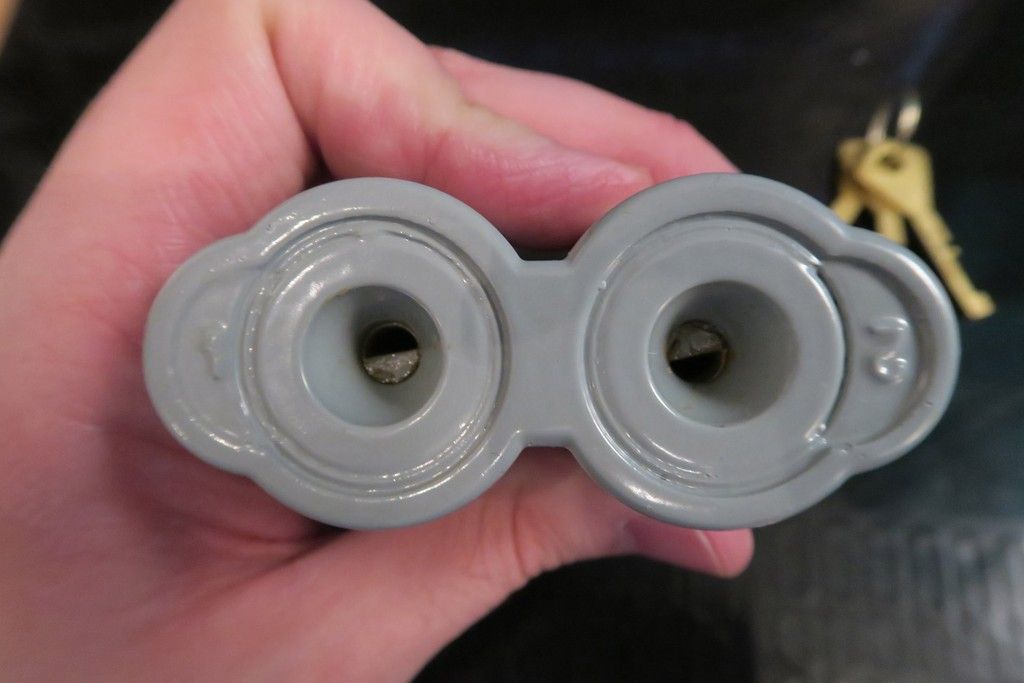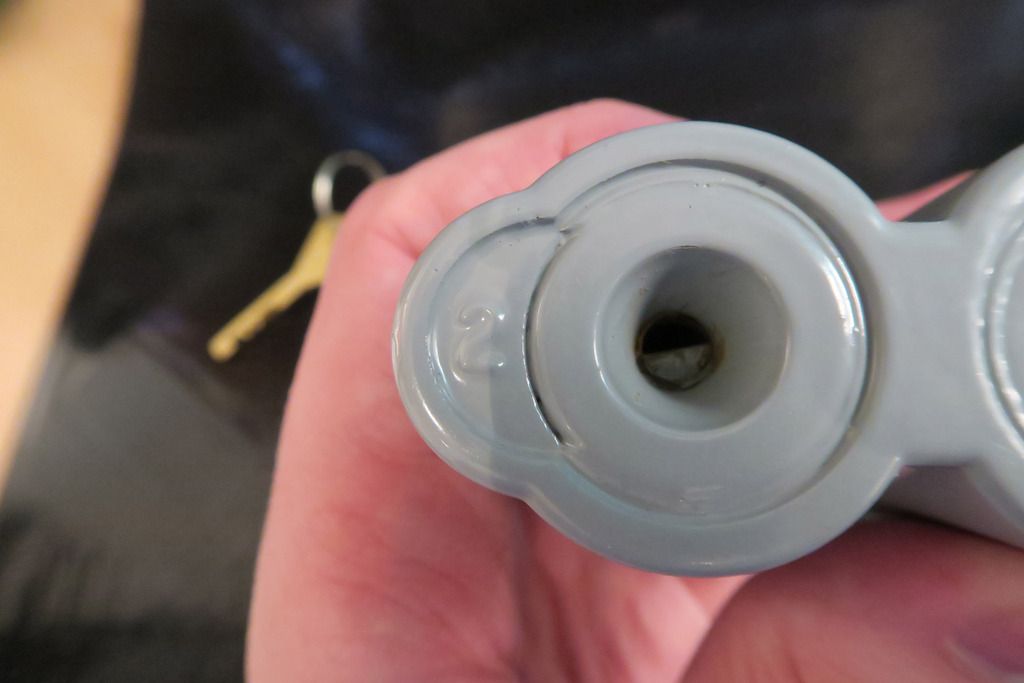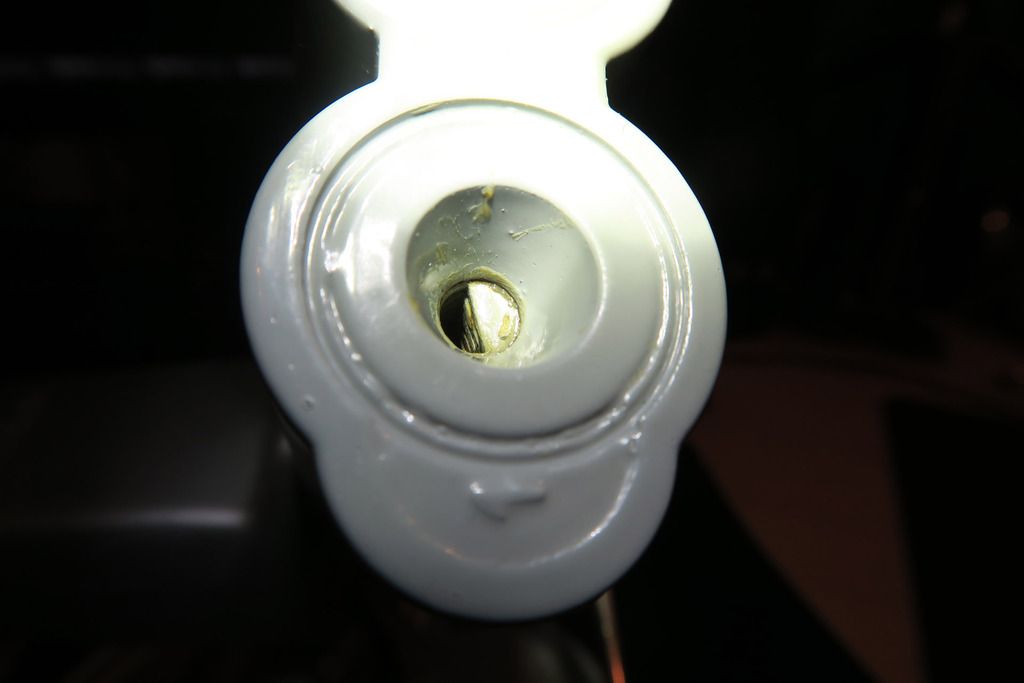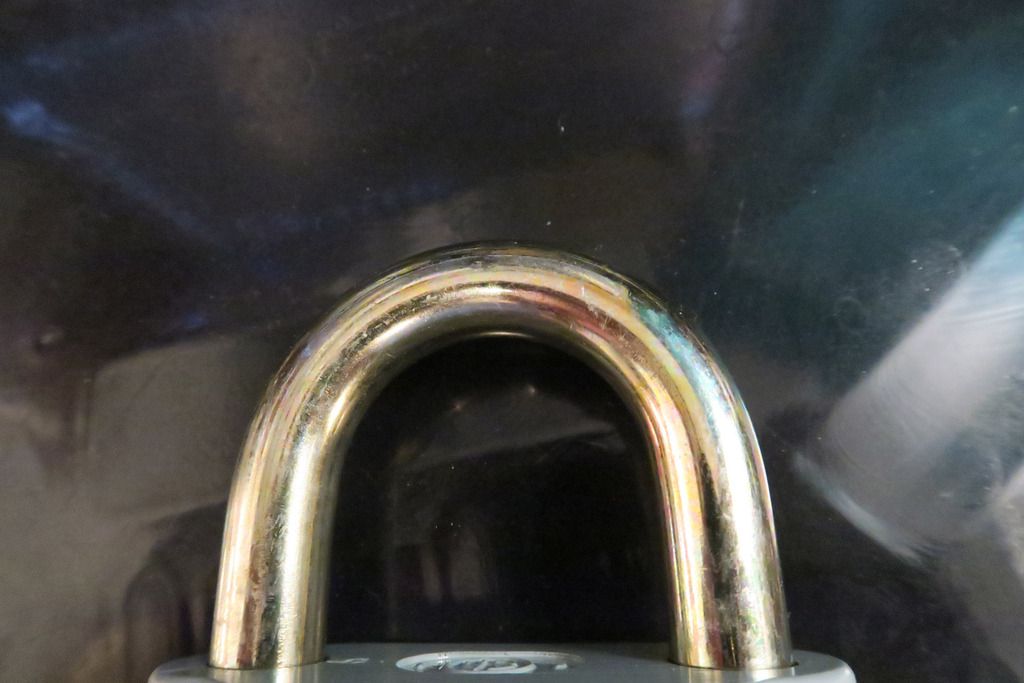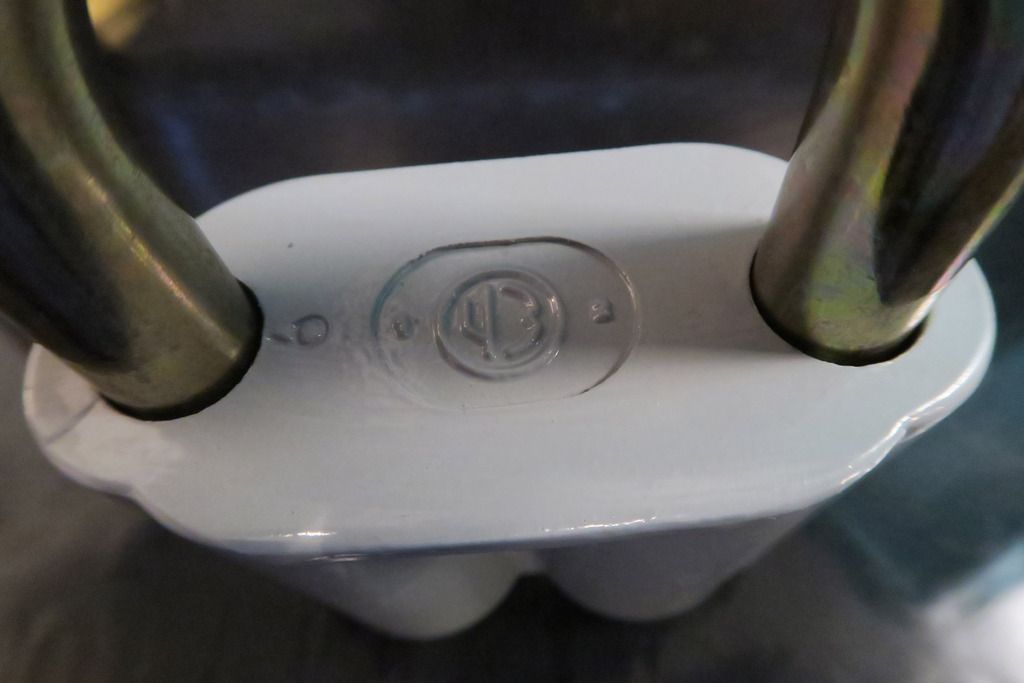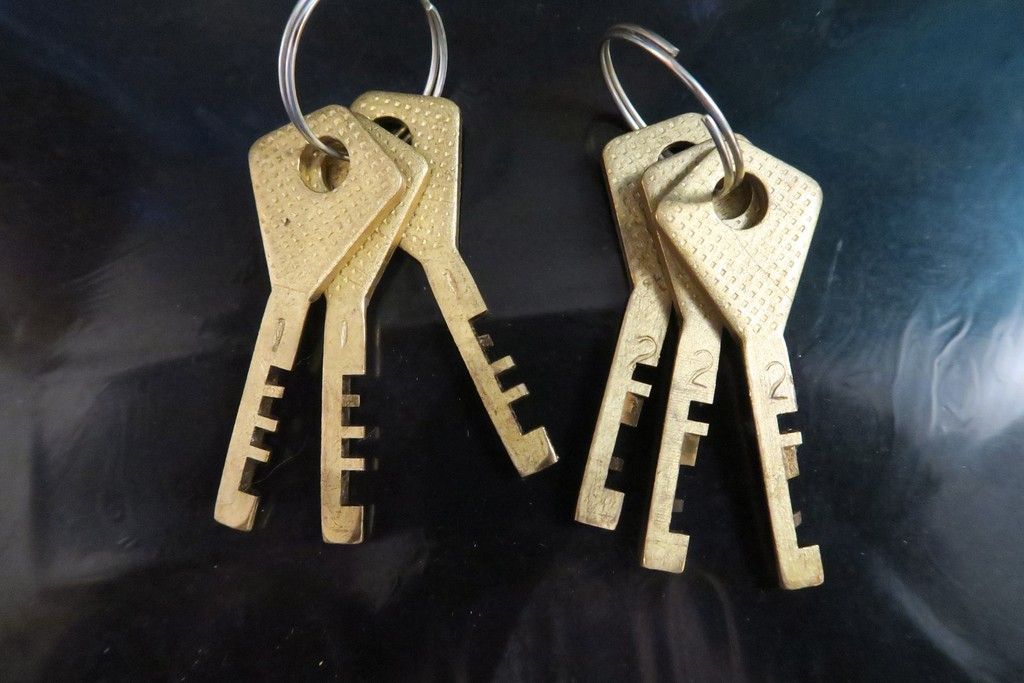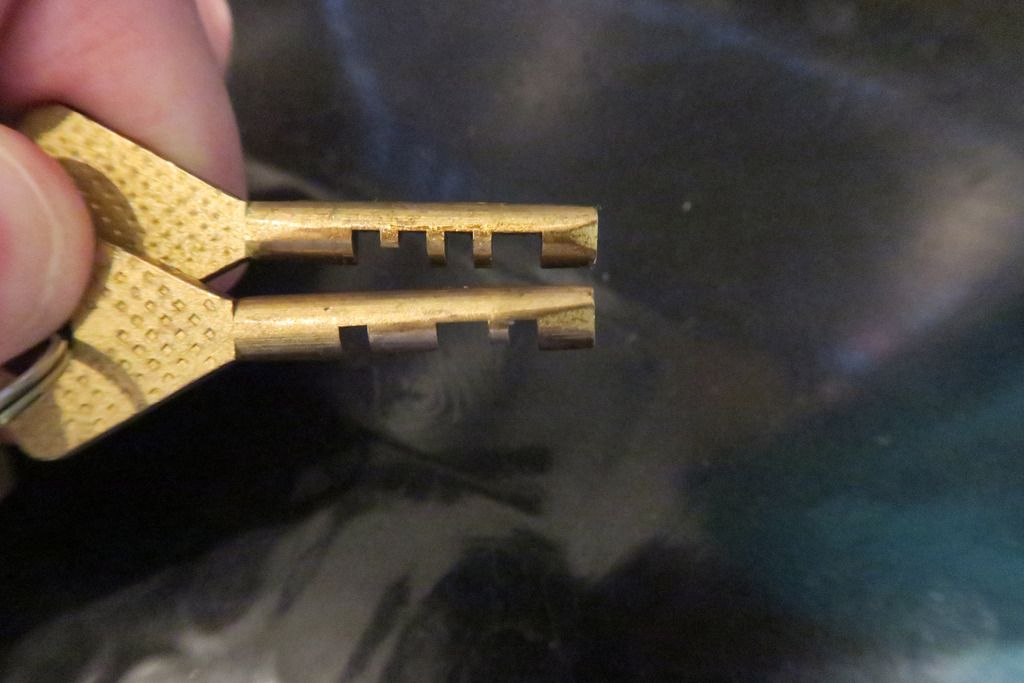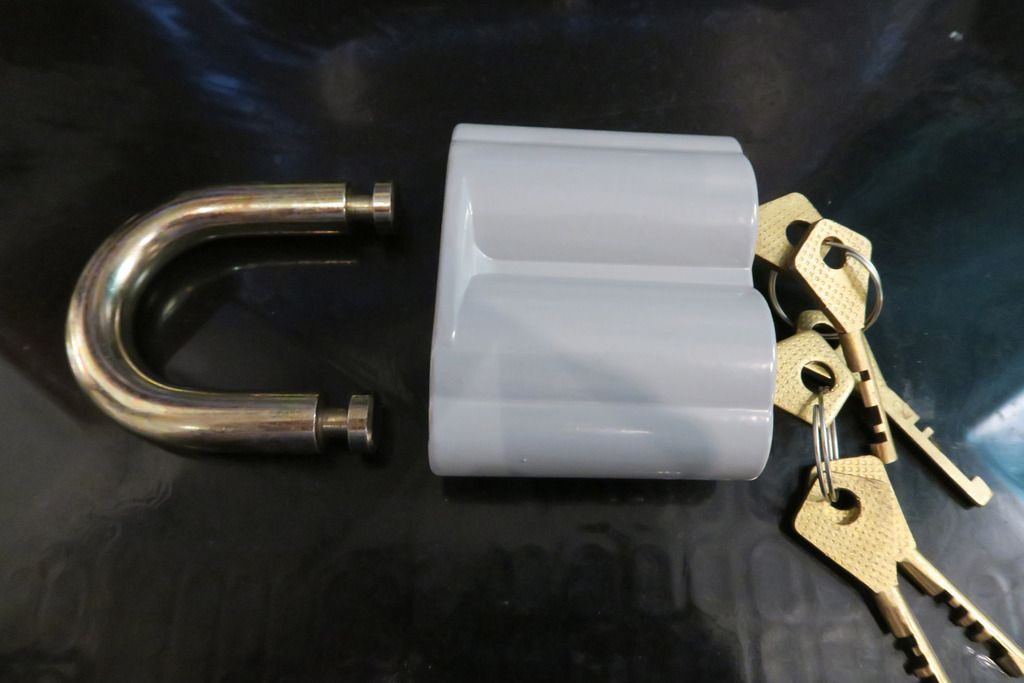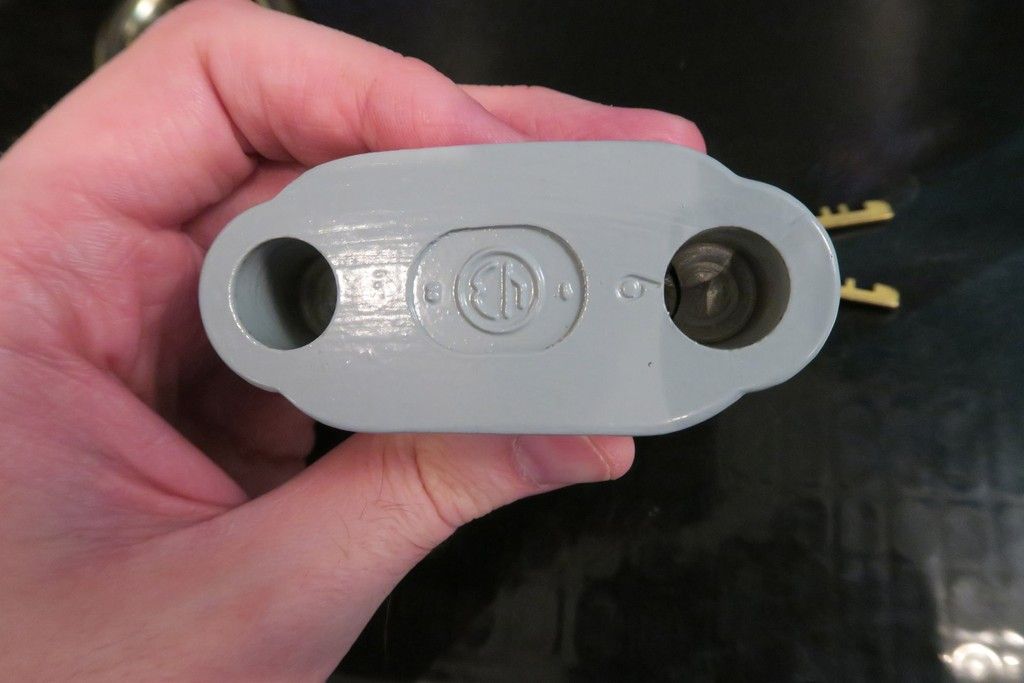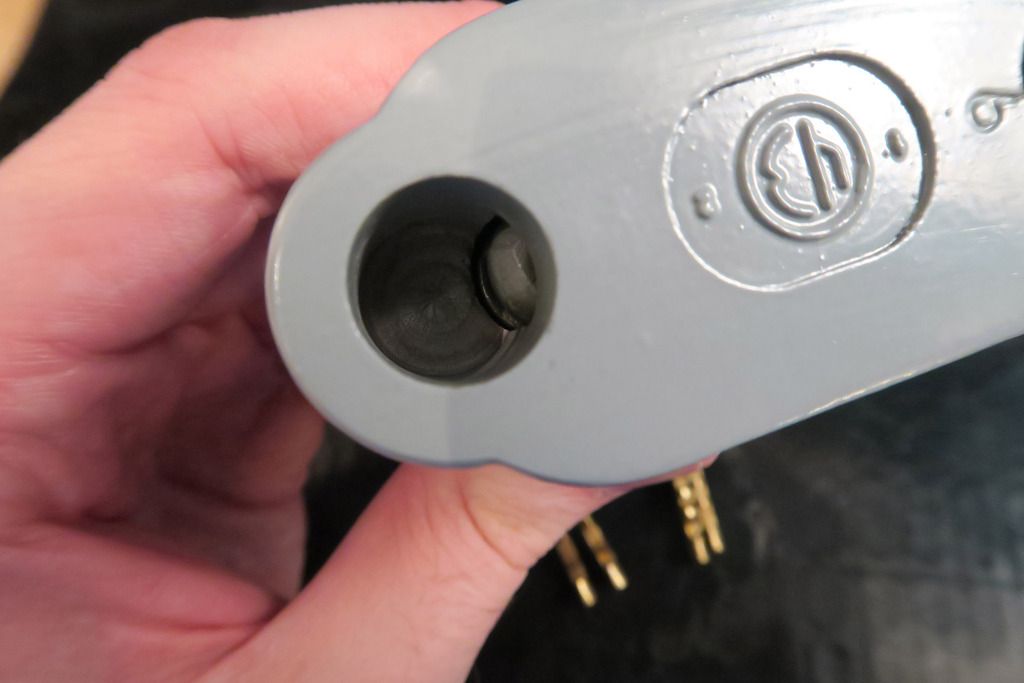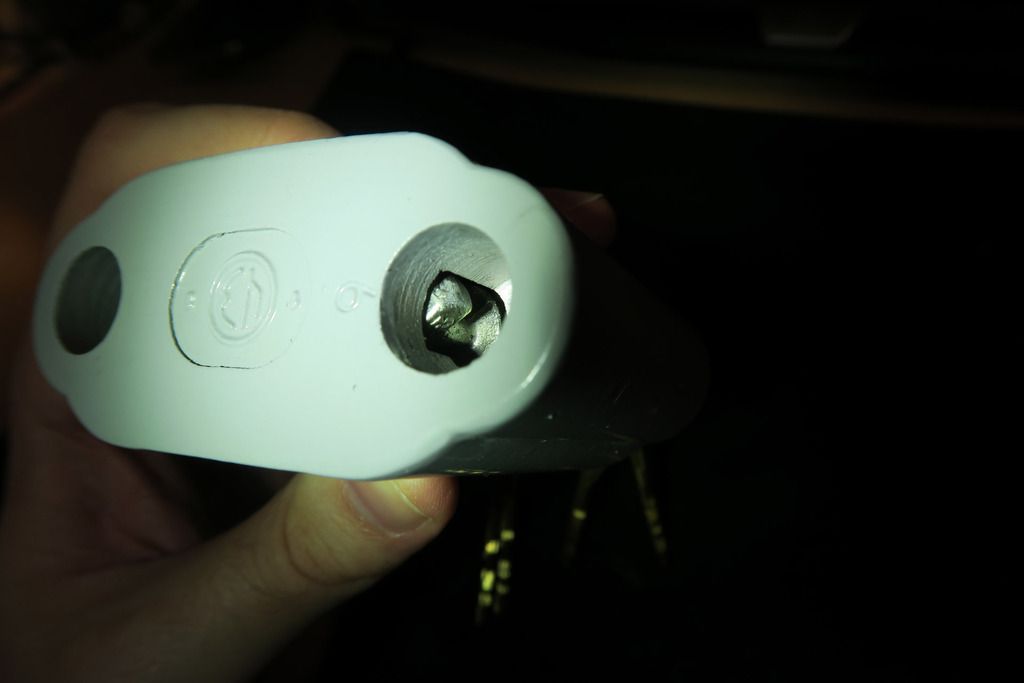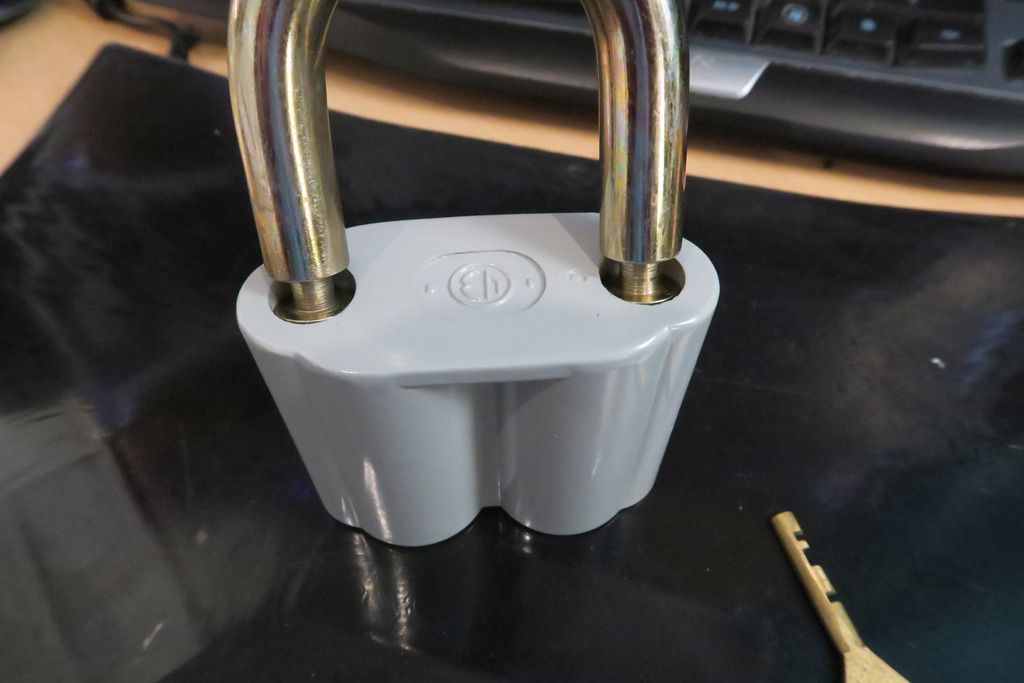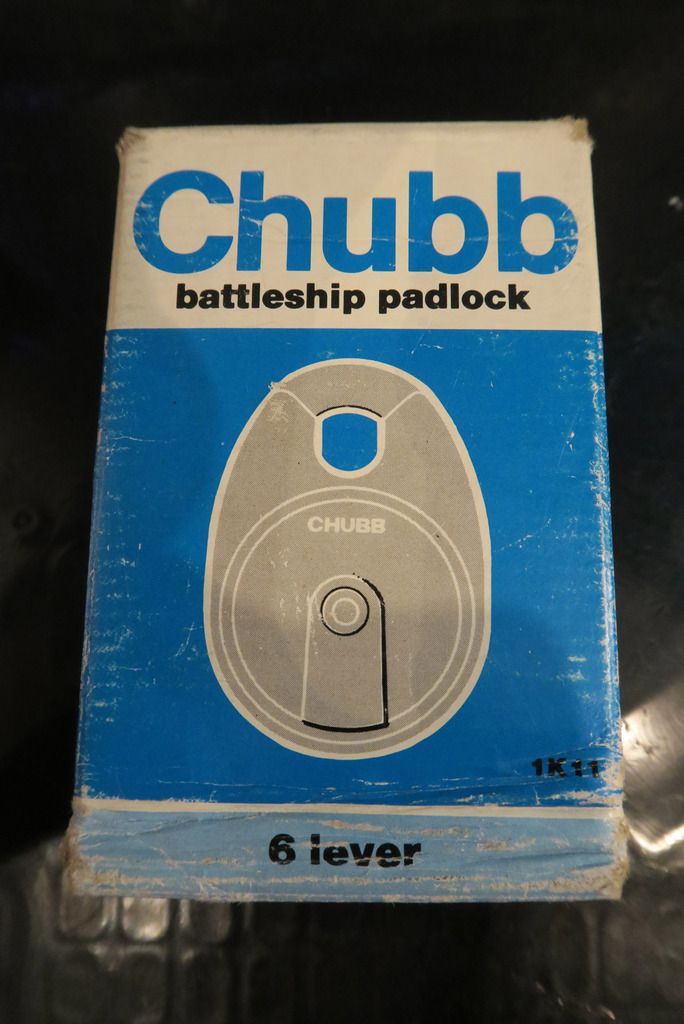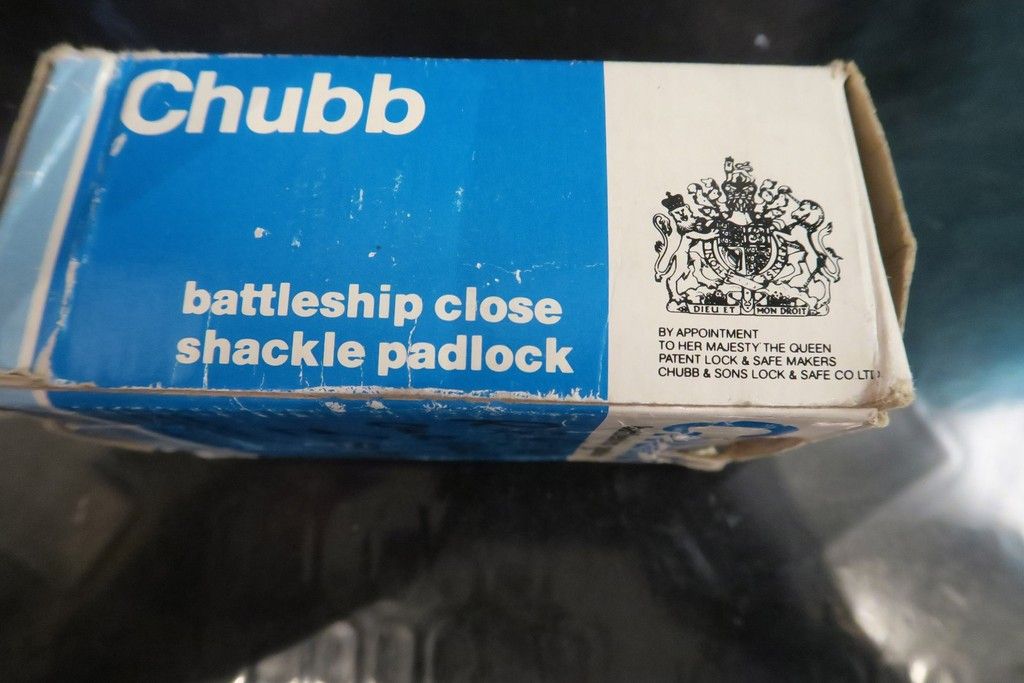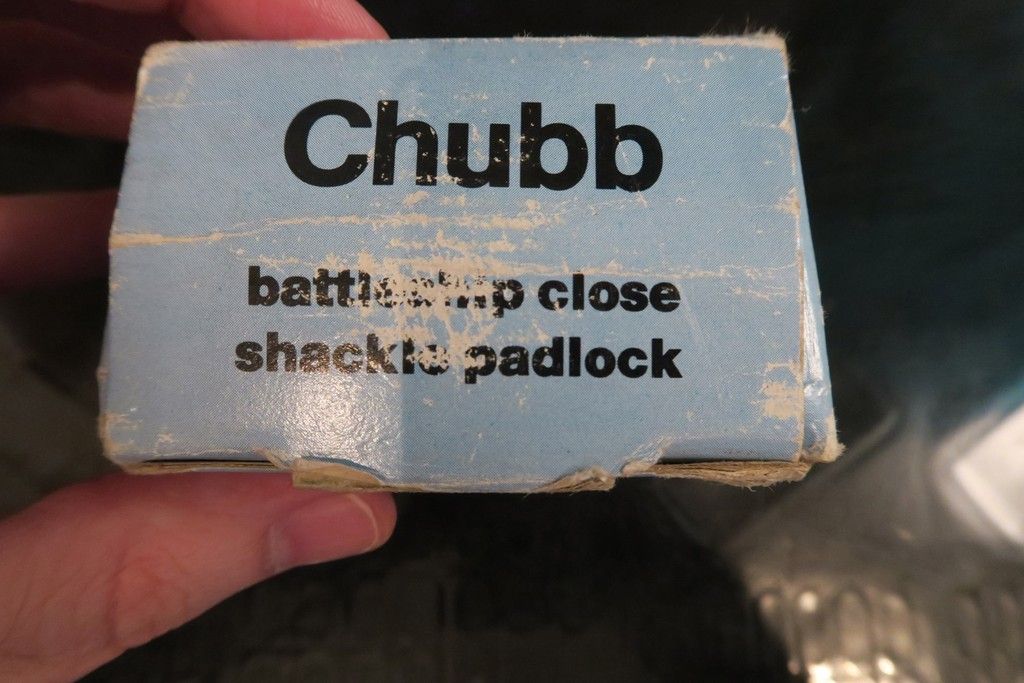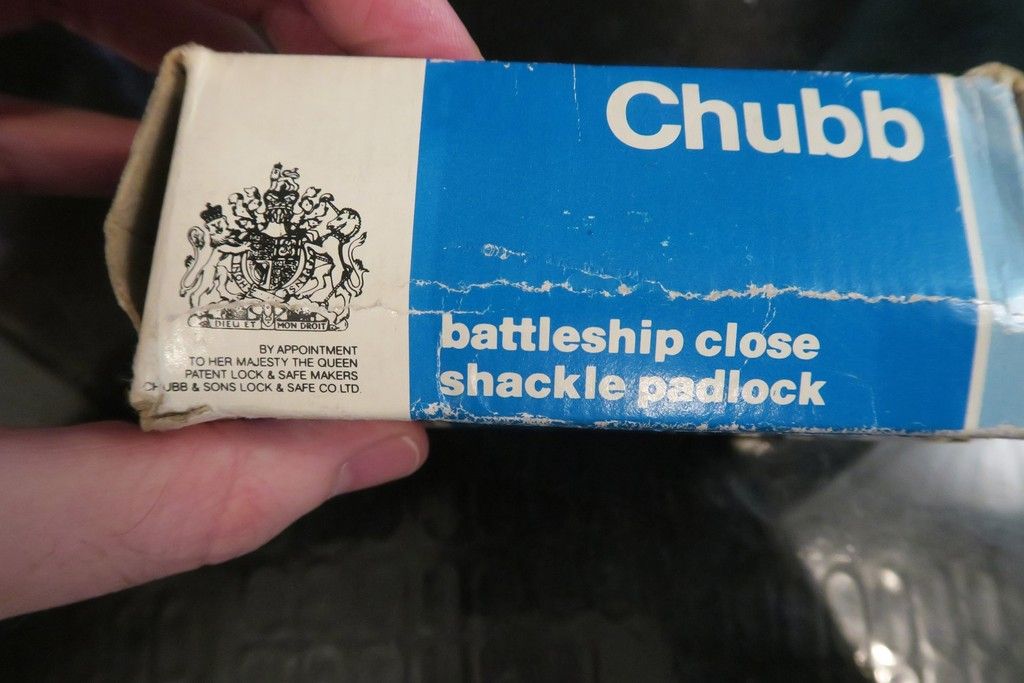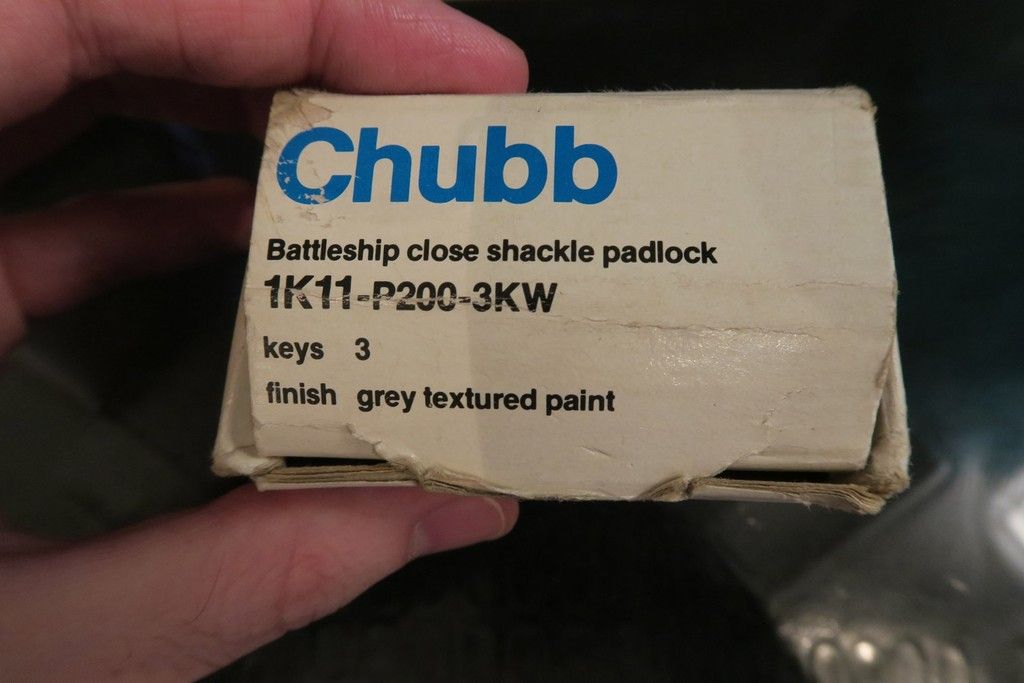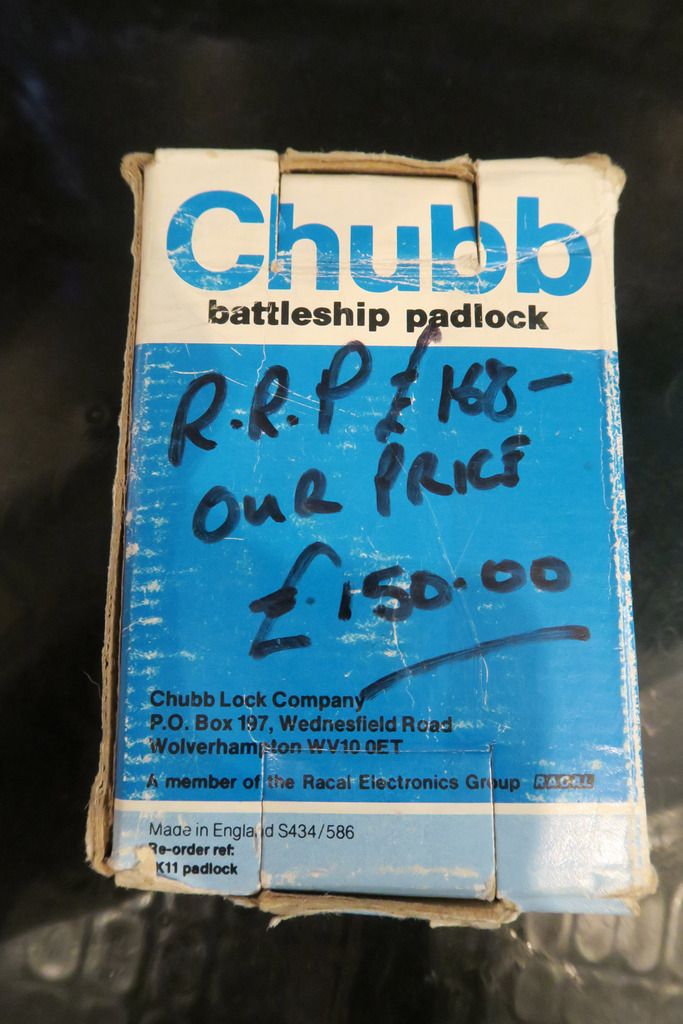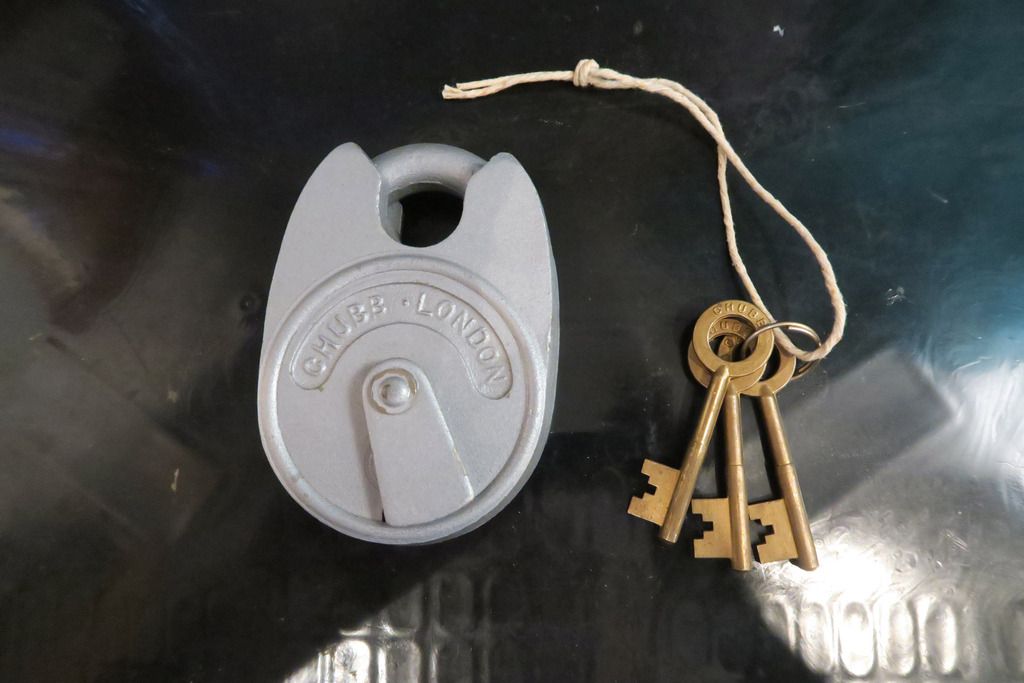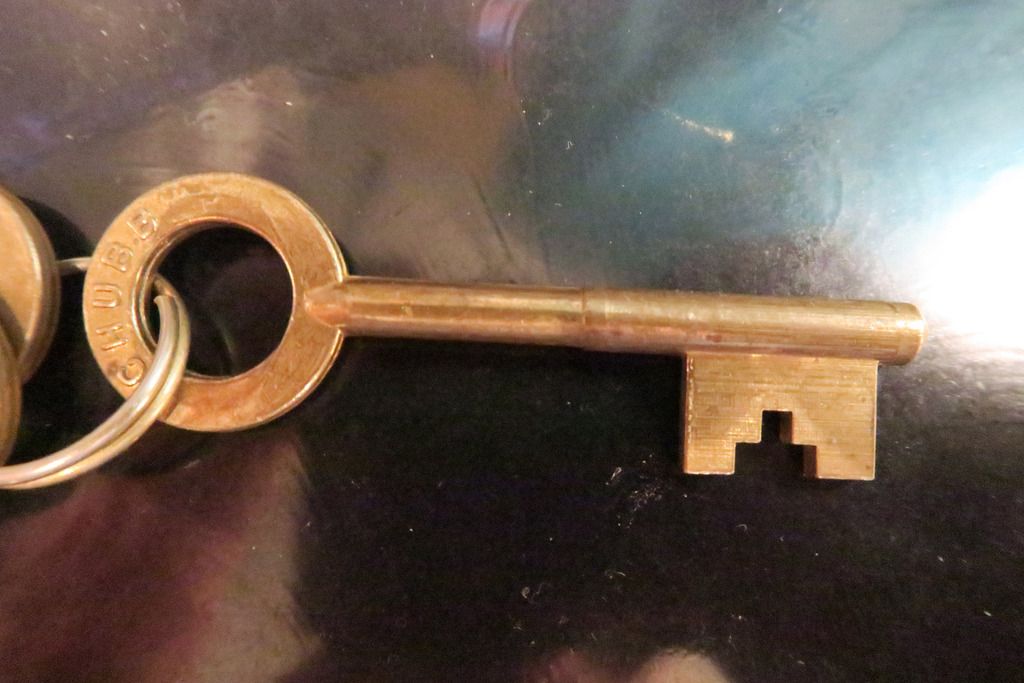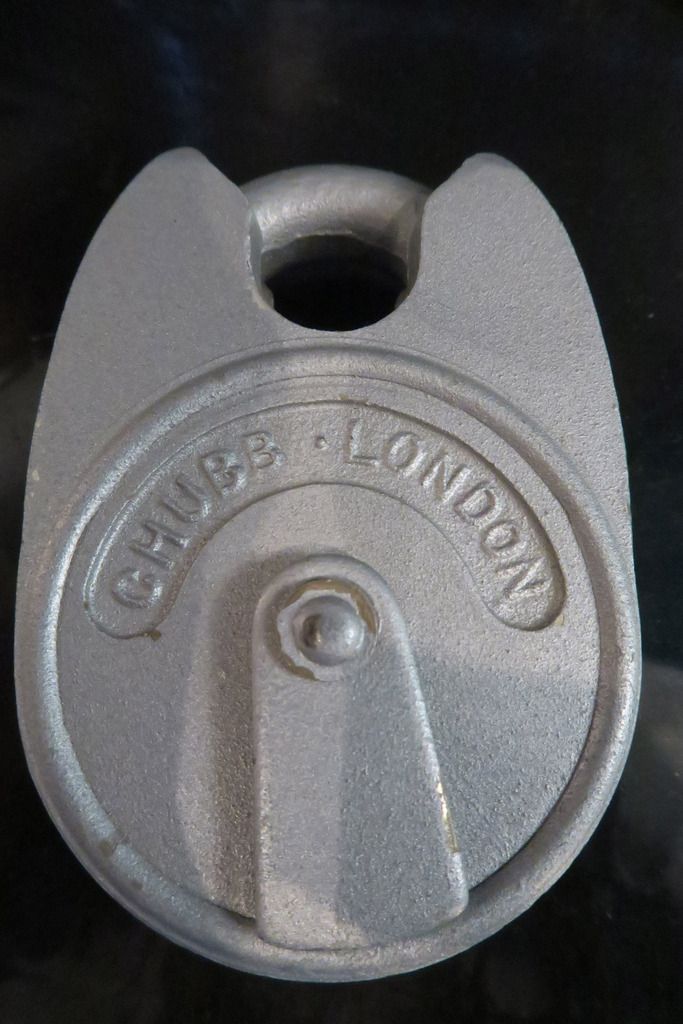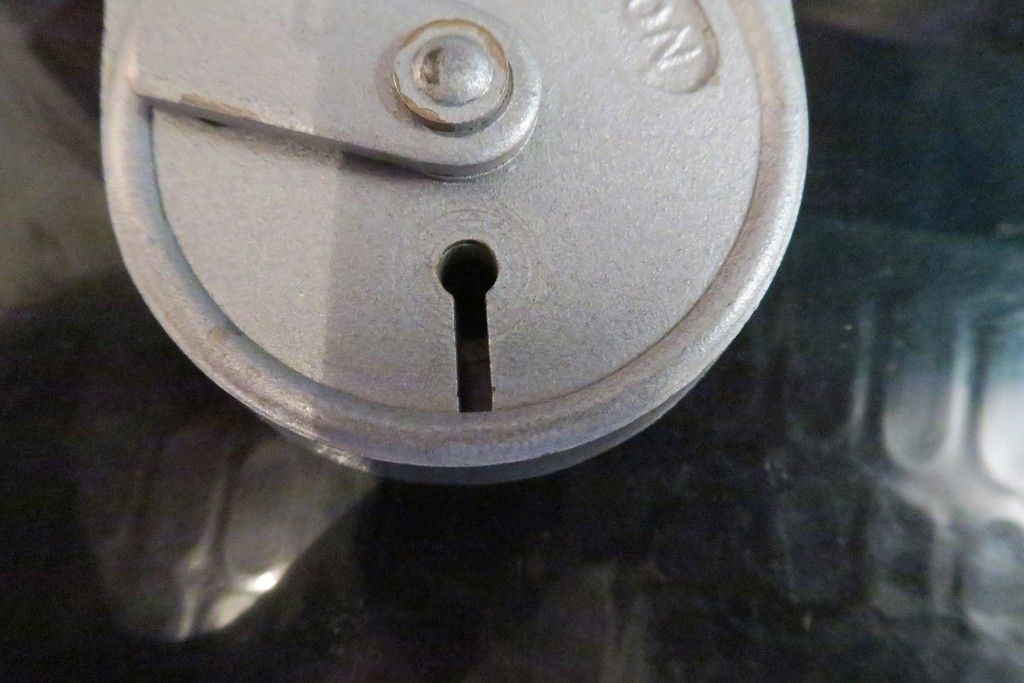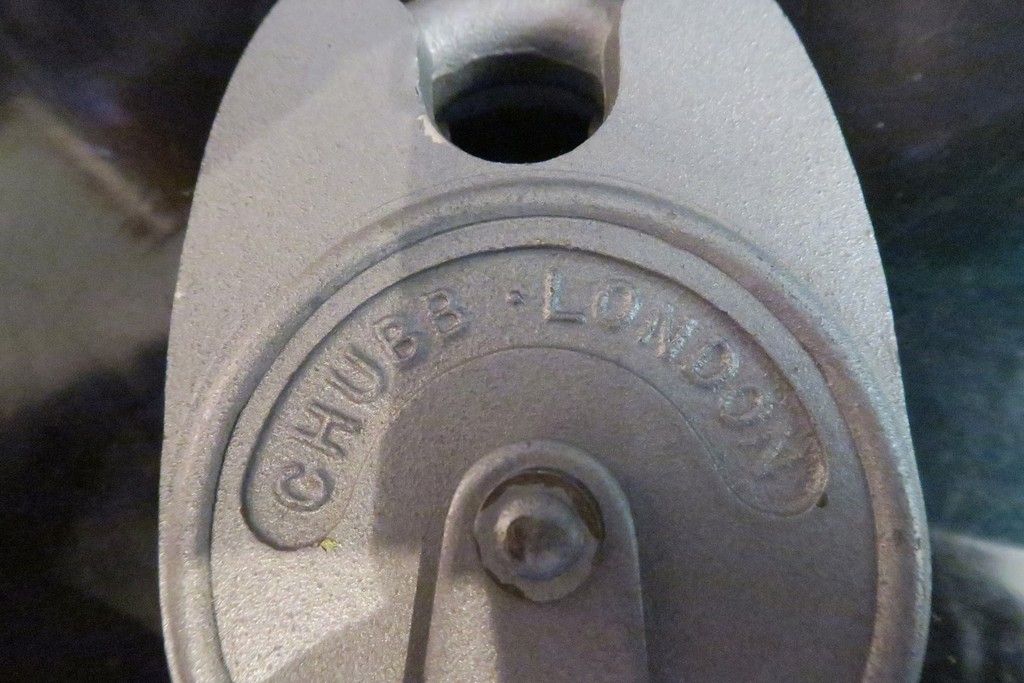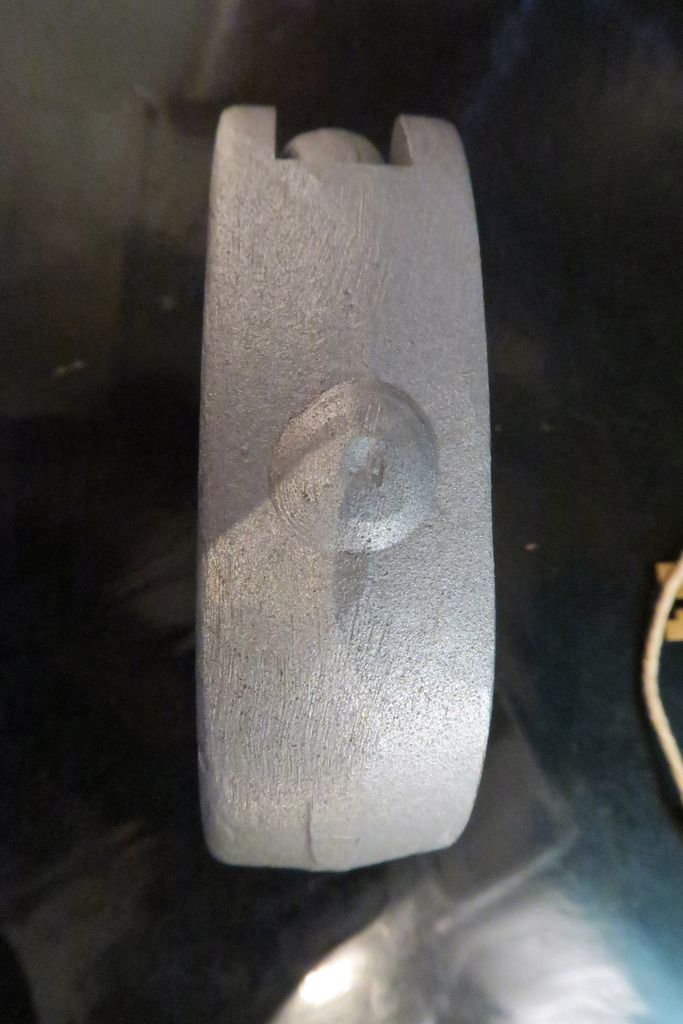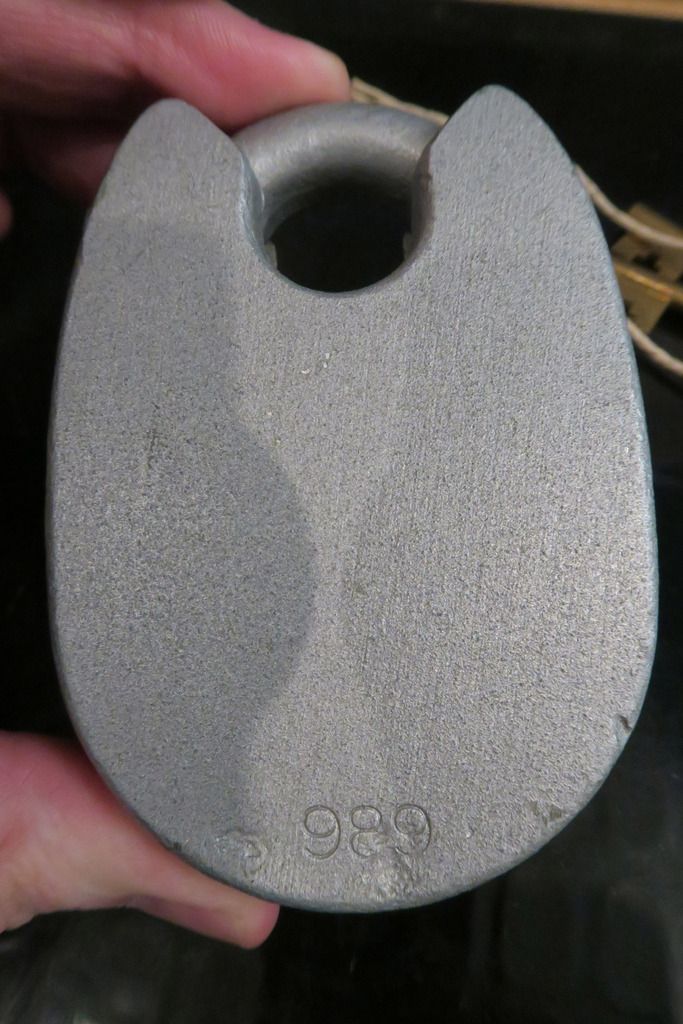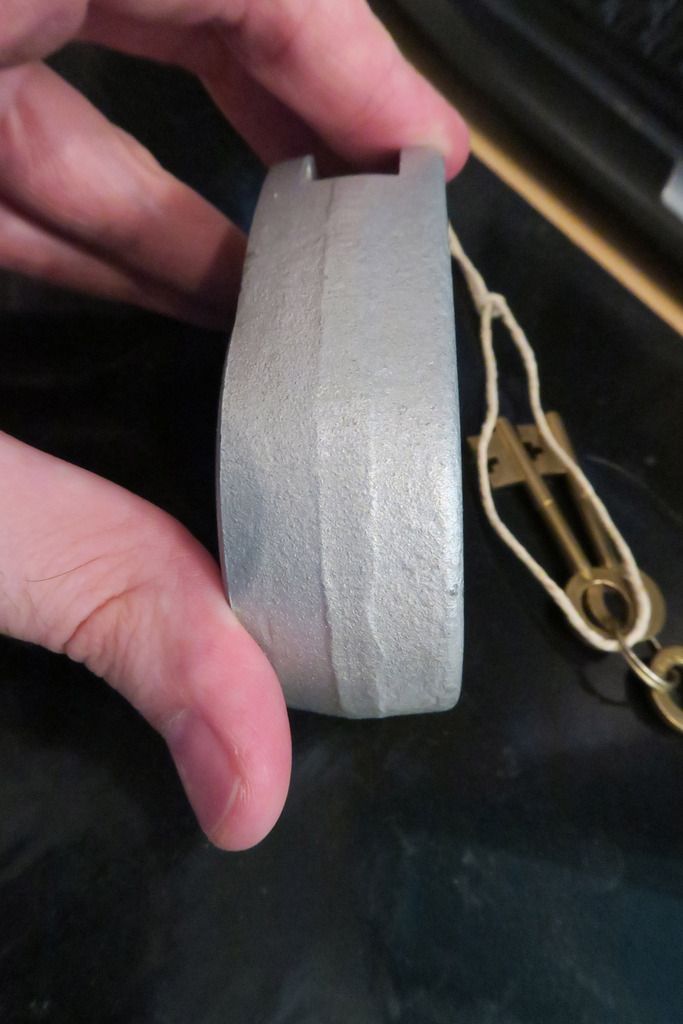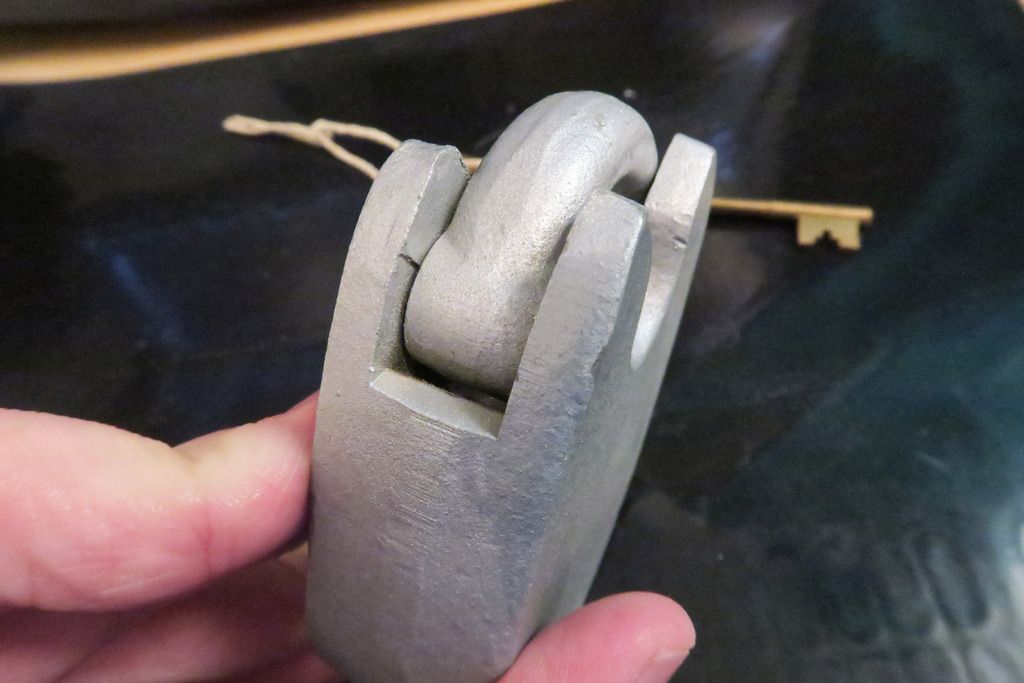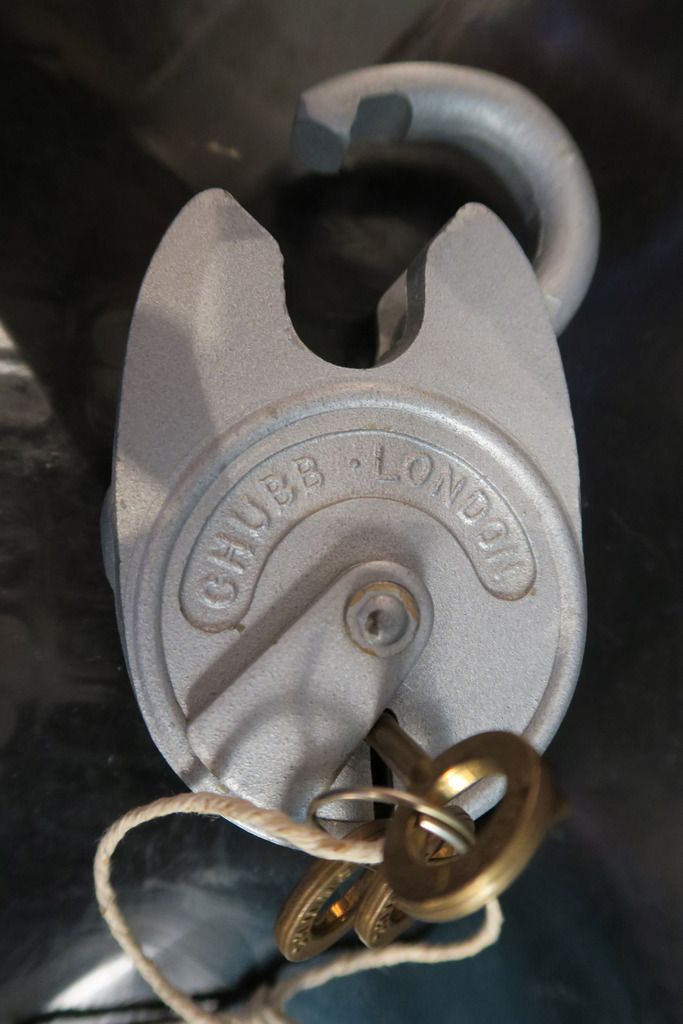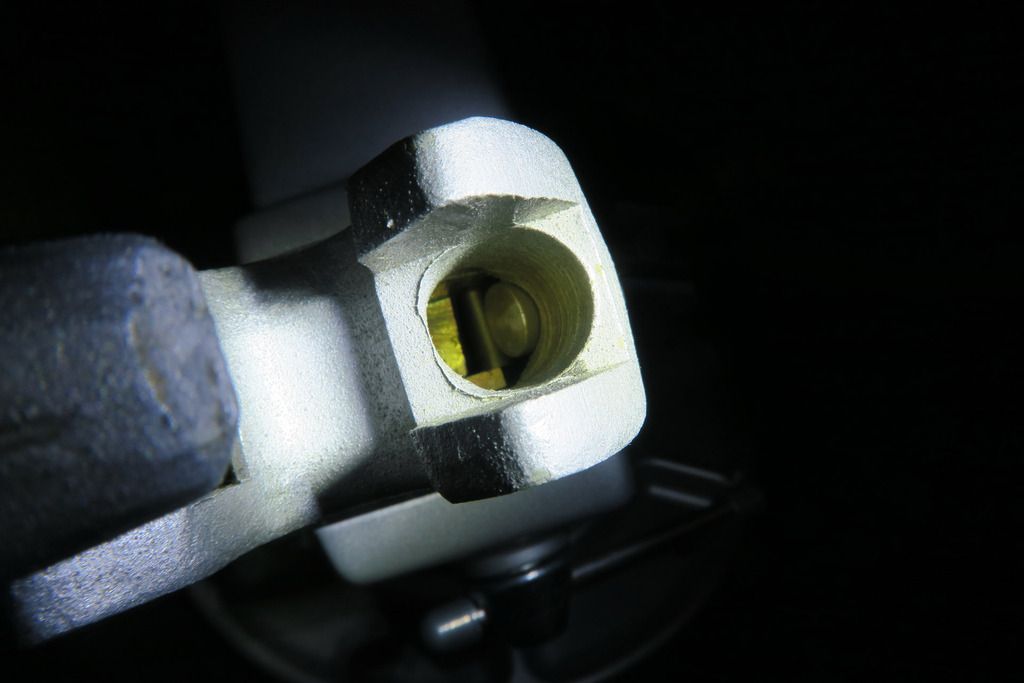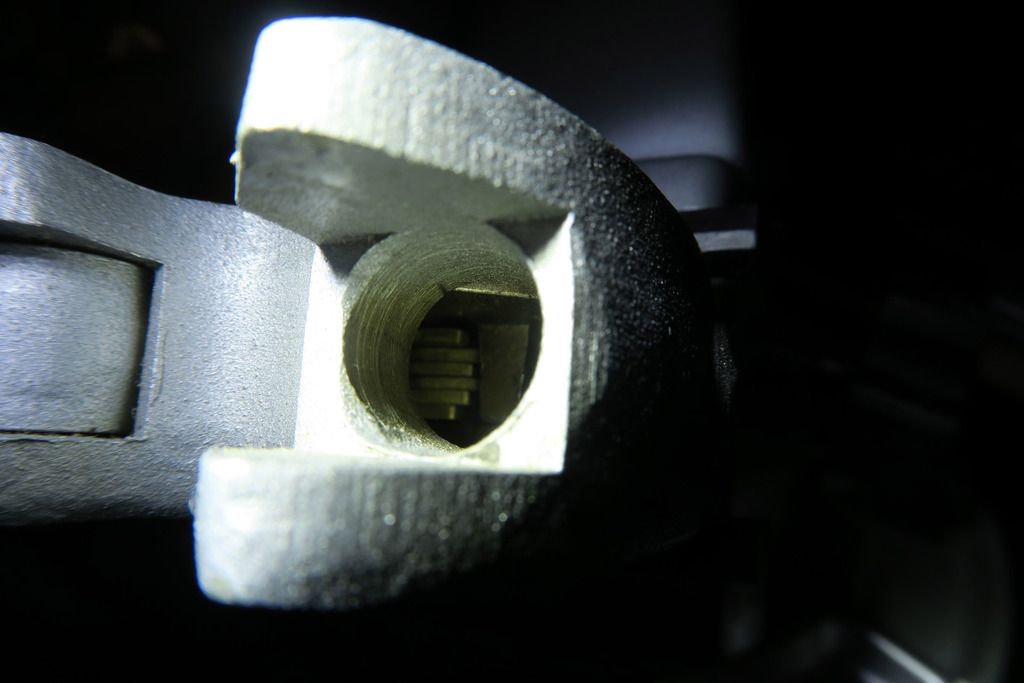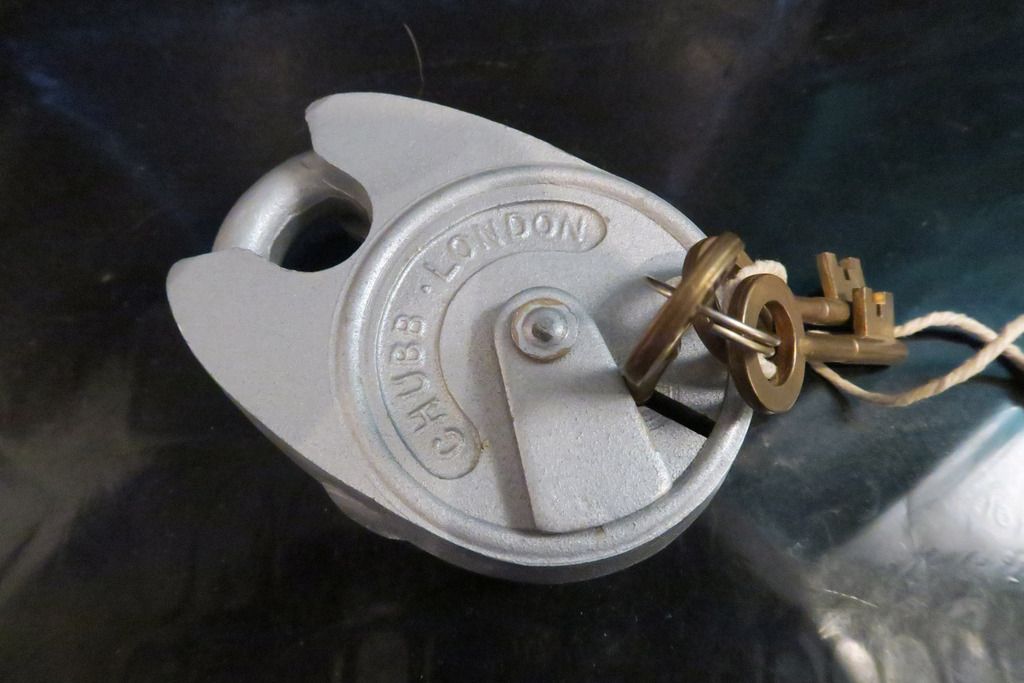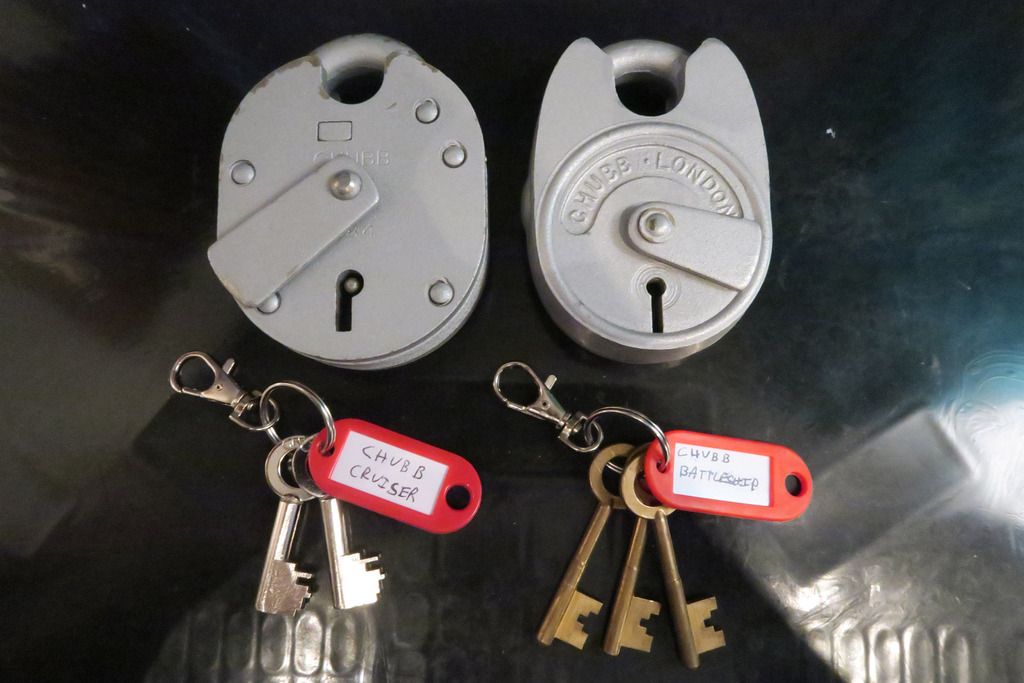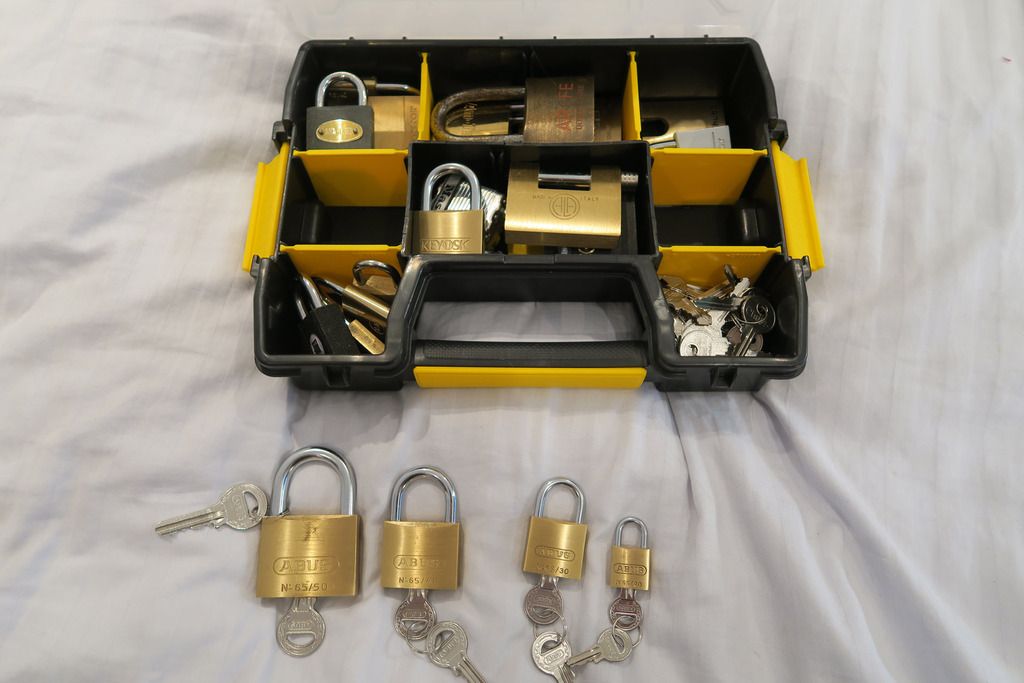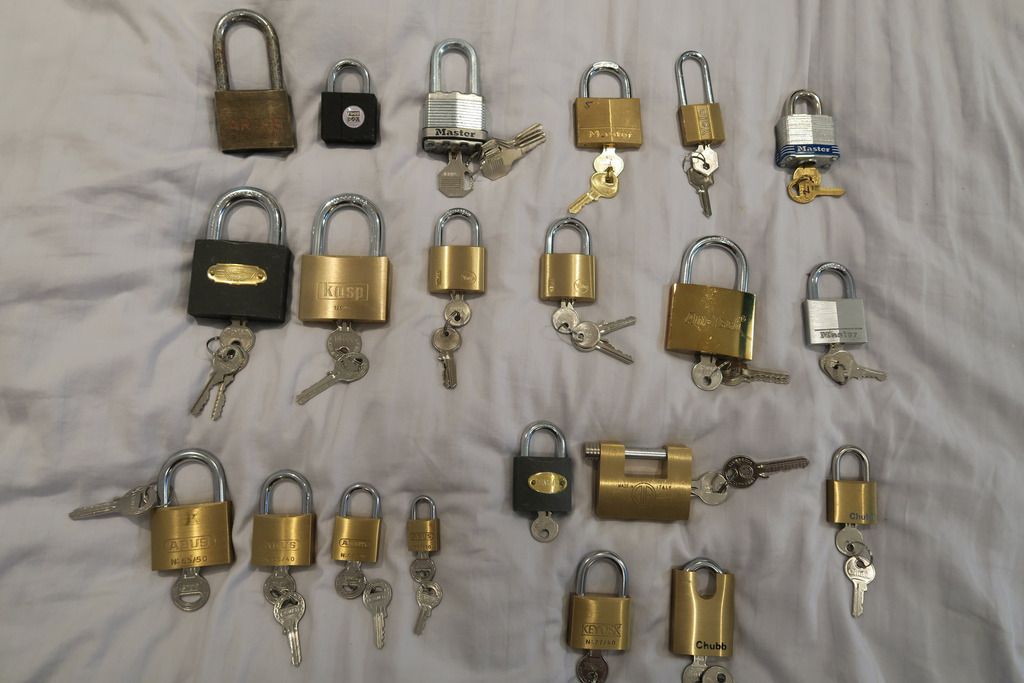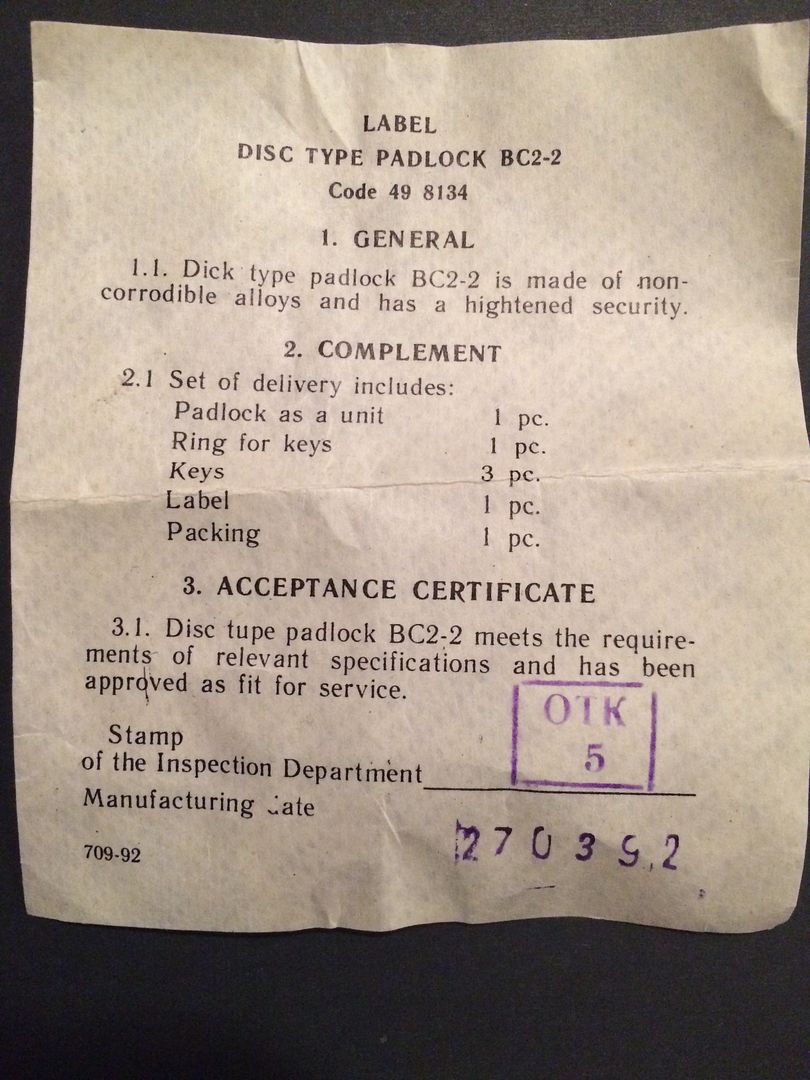So, a pretty cool update today IMO. This actually turned up a few days ago but I haven’t had time to set down and write this up until now. Note that this will be a long one, as it includes a cleanup too.
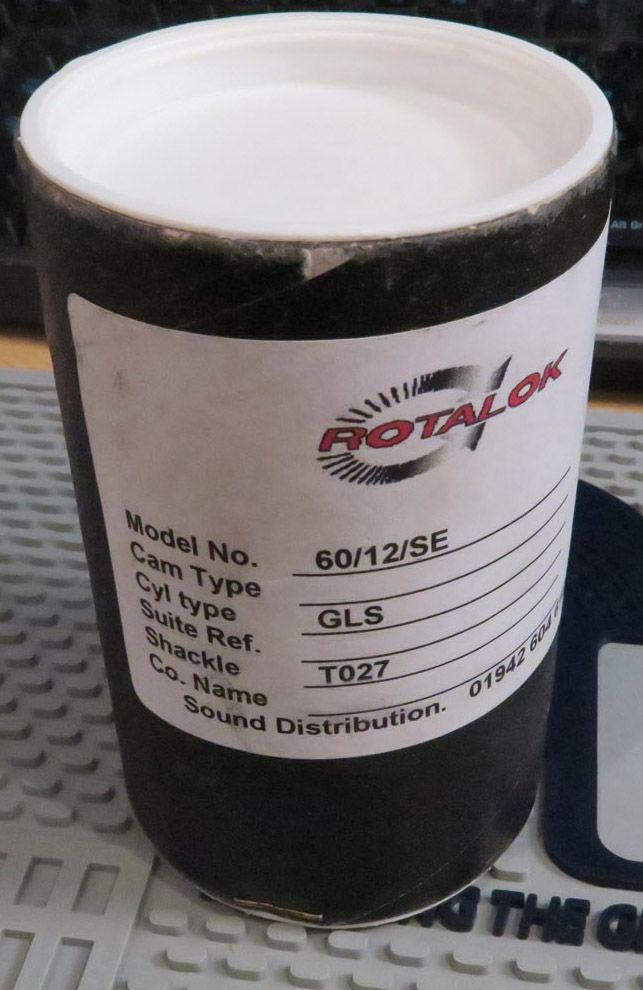
Yep indeed! It’s a Rotalok. These are pretty difficult to come by, I’ve been looking for one at a reasonable price for a long while and just so happened to be searching eBay when I came across one on an unrelated search for an extremely good price, and just had to snap it up. The only retail site for these that I know of is
Locks Online for a staggering £362
without a cylinder! (
This site also sells all three versions (open, semi closed and closed shackle) for a bit more cash, the latter two being especially pricy).
This outer box is interesting. For the price I paid, I was wondering whether this would be a genuine Rotalok, as I’ve seen many knock-offs out there including one in a lock shop near to me – I figured that, in the worst case scenario, I’d have a cool Rotalok clone that still would make an awesome addition to my collection. From the pictures, however, the lock did appear to be genuine when comparing it to others such as the LocksOnline one and BosnianBill’s review/picking of the same.
The box itself is, as far as I can tell, the original and official box as I’ve seen the same style elsewhere. At the bottom of the label though is written “Sound Distribution.” I figured that it must be a lock from a series made especially for that company, so I did a bit of digging and it seems that this was a company (now defunct, or at least their website is now effectively parked) that supplied motorcycle parts, so maybe they were a distributor for Rotalok padlocks for use as motorcycle chain padlocks.
Unboxed:

If you haven’t heard of Rotalok, it’s an interesting padlock for sure. The body is cylindrical, and consists of the inner core potion that is attached to the bottom cylinder protecting plate, the top shackle guard (shoulders for the semi-closed/closed versions, or just a “top base” for lack of a better word, for the open shackle version), and the shackle itself. Then, around the middle of the main part of the body is a free-spinning outer shell, connected to the inner core with ball bearings. The main emphasis on this lock is to do with preventing the gripping of the lock with a pipe wrench or similar in order to twist and snap the shackle, as the body will spin continuously. It’s a cool concept!
In the photo above you can see the shackle and shroud at the top – those are connected to the inner core, along with the bottom plate which you will see shortly. The main body section – which you can see is separated from the top assemble with that seam, and is of a slightly different colour – is the part that spins.

Close up of the body. I’ve seen other ‘versions’ of the Rotalok written differently, such as “Rotaloc”, with or without the “Made in England” stamp. I’m pretty sure this is the genuine article – it’s tough to be sure, as there doesn’t seem to be an official manufacturer or website for these locks. Apparently they are used in HM Prisons service so it would make sense if the details are kept highly under wraps, similar to the shroud of silence around the S&G Military padlocks.
Here, on the front* of the lock, you can see two bored holes in the shackle guard portion of the lock:
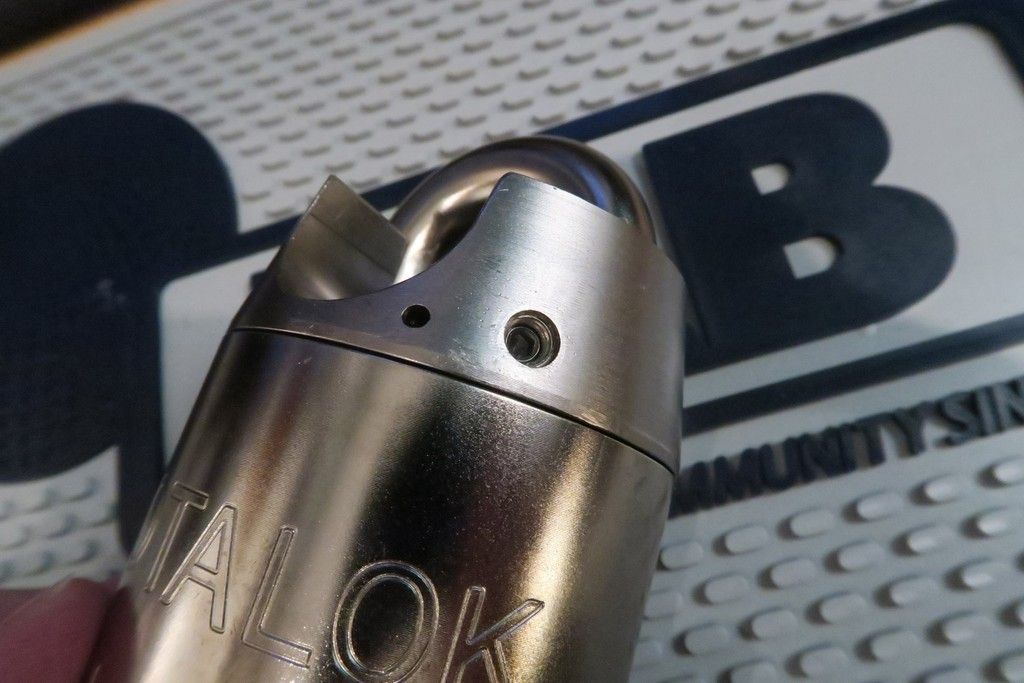
The little hole lines up with a hole similar to the screw on the right (and, indeed, with the same screw in it) and contained within this hole is a rod that holds the shackle in, but we’ll get to that. The screw on THIS side, I assumed was for removing the shoulder guard piece and disassembling the lock, but upon removing the screw there appears to be nothing behind it and even with the shackle removed I was unable to separate the two halves of the padlock, so I honestly have no idea what the purpose of this screw is.
* (‘Front’ is relative since the body spins. I’ve taken to calling this side the “front” and the other side, with one screw, the “back” for no particular reason. I try to line up the Rotalok stamped portion of the body with this area, for aesthetic reasons)
Here’s the screw on the other side (“back”) that aligns with the small hole on the other side, as just described:
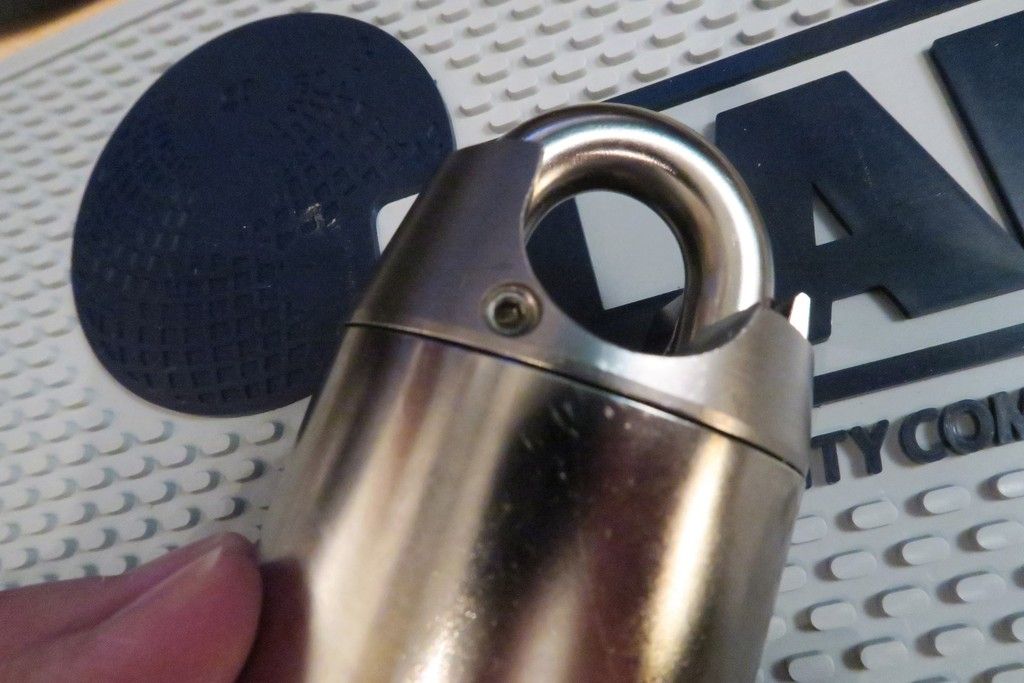
The bottom of the lock:
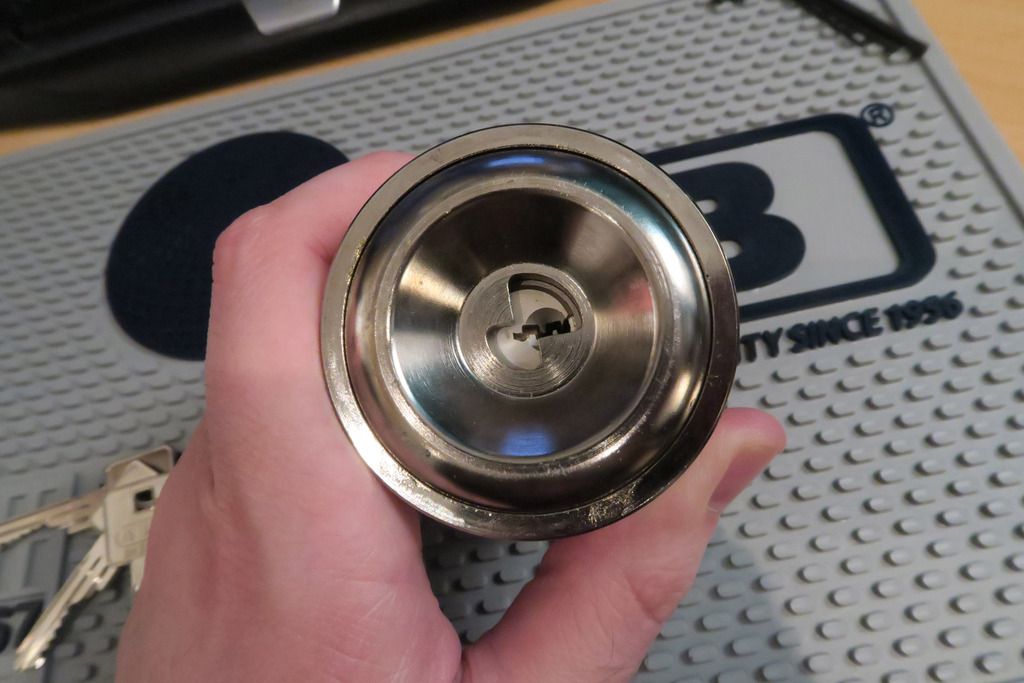
The Rounded shiny centre portion is fixed with screws (similar to the Ingersoll assembly method) to the central “core” body, whereas the spinning section can be seen as that outer “disk” around 4mm wide separated from the inner section. The core inside is currently an
Abus E60 half-cylinder, which is what the lock shipped with.
The key:
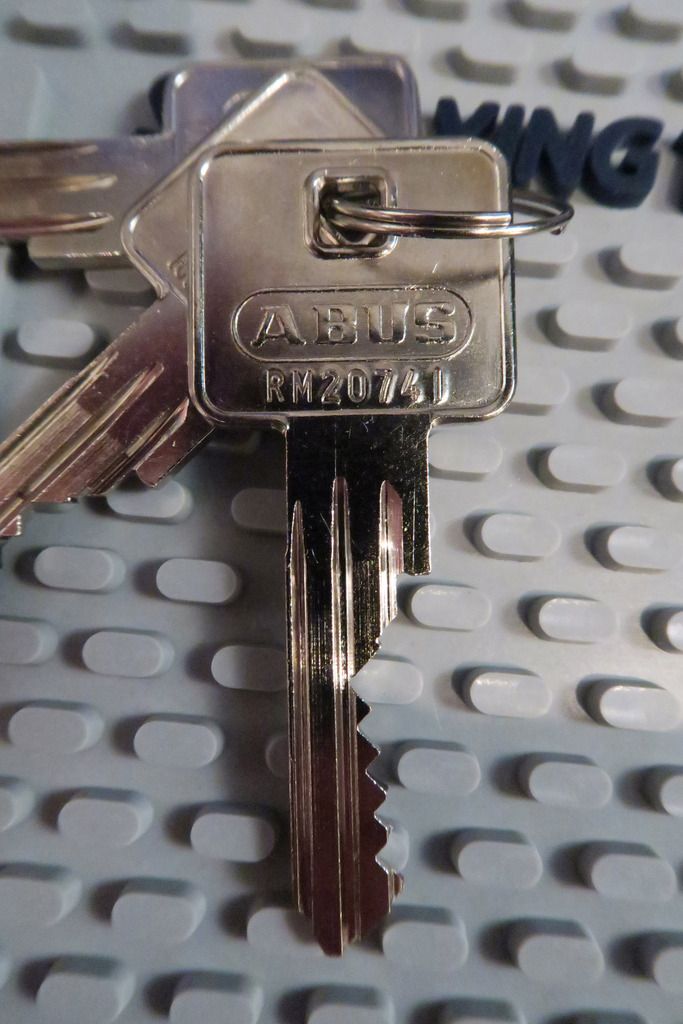
Shoulders / shackle guard:
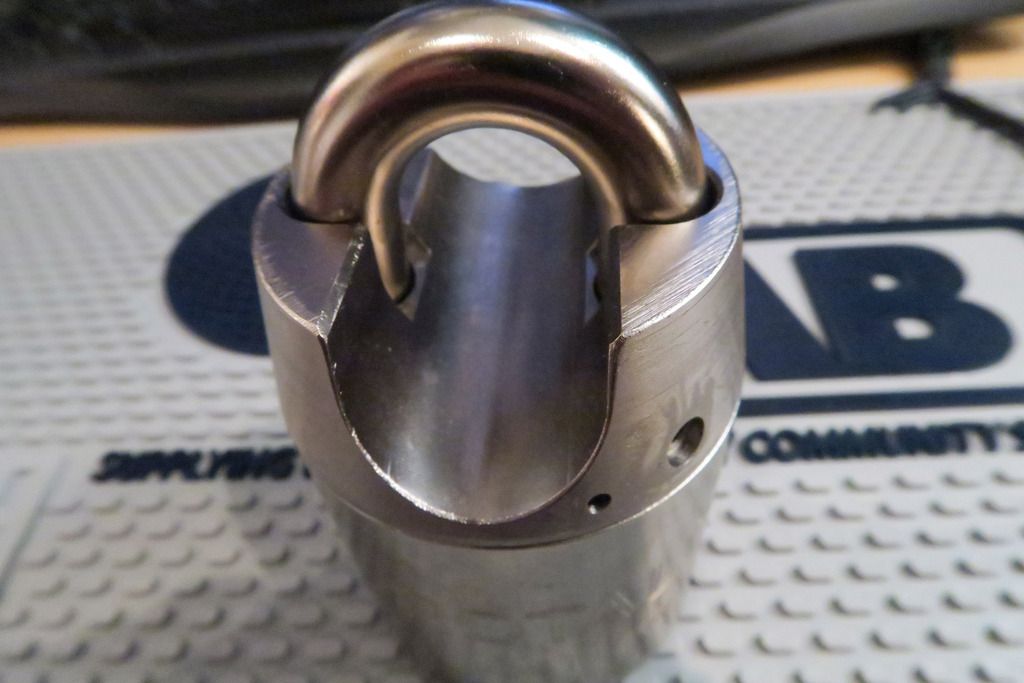
It’s very chunky. Reminds me a lot of my Ingersolls but maybe it’s just a standard shape/design for these high security locks.
Key in lock, unlocked:
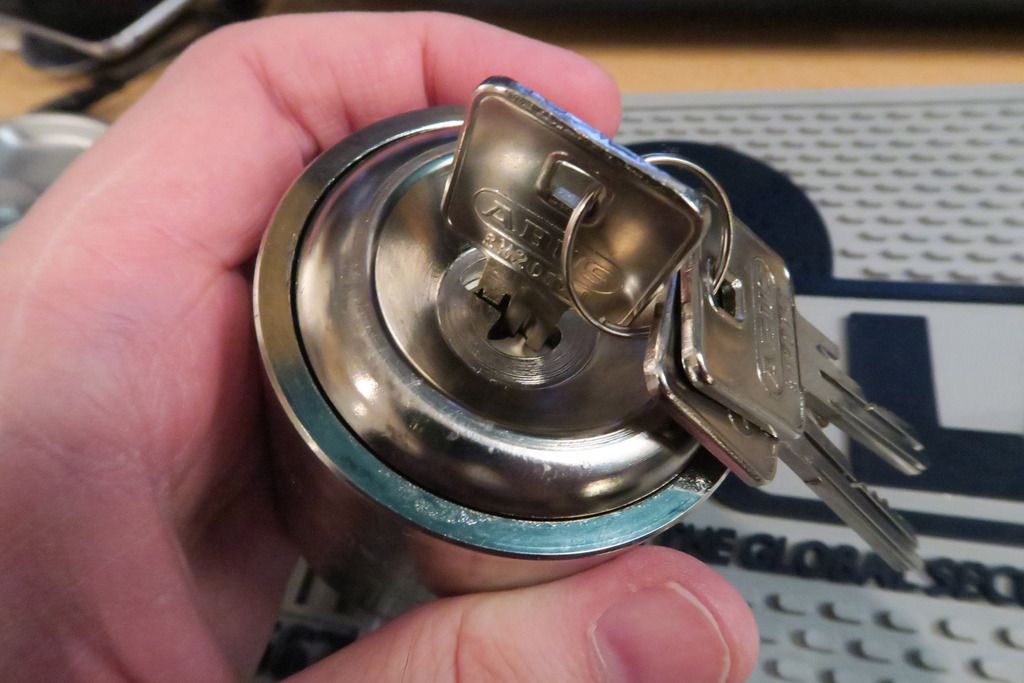
Lock open:

Once open, you can see a large hex screw down at the bottom of the shackle hole. Much like the Ingersolls, there are two of these – one in each shackle hole – holding the bottom plate on, and also much like the Ingersolls you have to jump through some hoops to get the shackle fully out. Note the pretty milling marks in the closed-shackle cutout:

These are the three hex keys you’ll need to disassembly this lock:
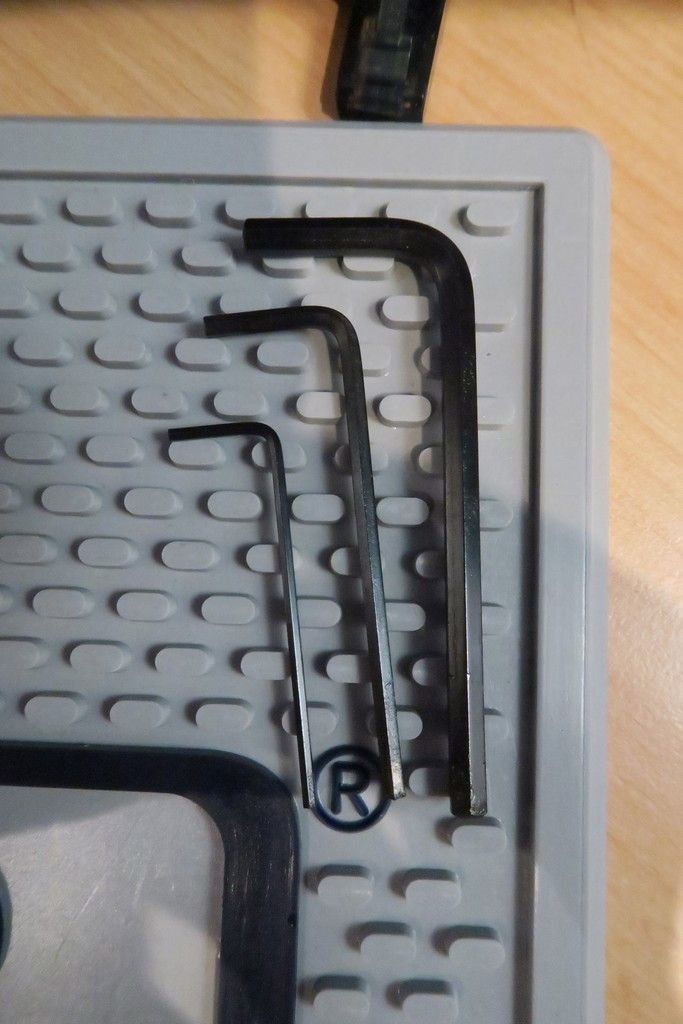
The largest one, size ‘4’ (4mm I assume) will remove the two large hex screws holding the bottom plate in. The next size down, ‘2’, is used for removing the grub screws. The smallest one – doesn’t really matter what size, but it needs to be little, or you can use another equally small, thin stick – is used to push the shackle retaining bar out through that little hole in the front of the lock.
To disassemble the lock, start by unlocking the shackle. You need to do this because you cannot remove the key whilst the lock is open, and you cannot lock the shackle open because of the BBs that lock it closed. Then remove this screw (the hex screw that’s on its own on the body, NOT the one next to the little hole):
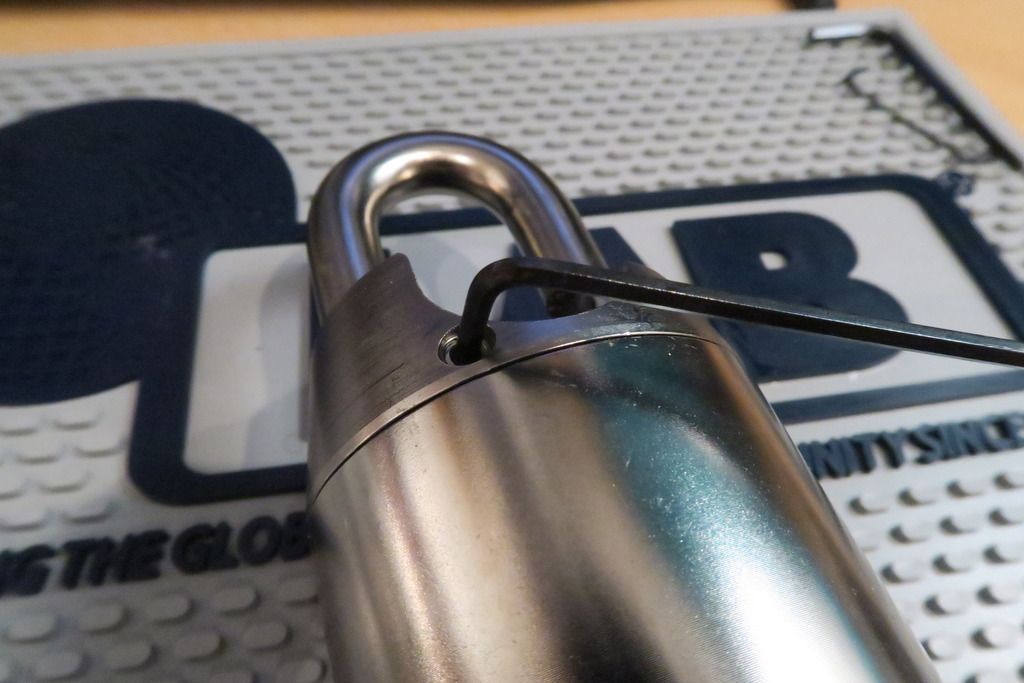
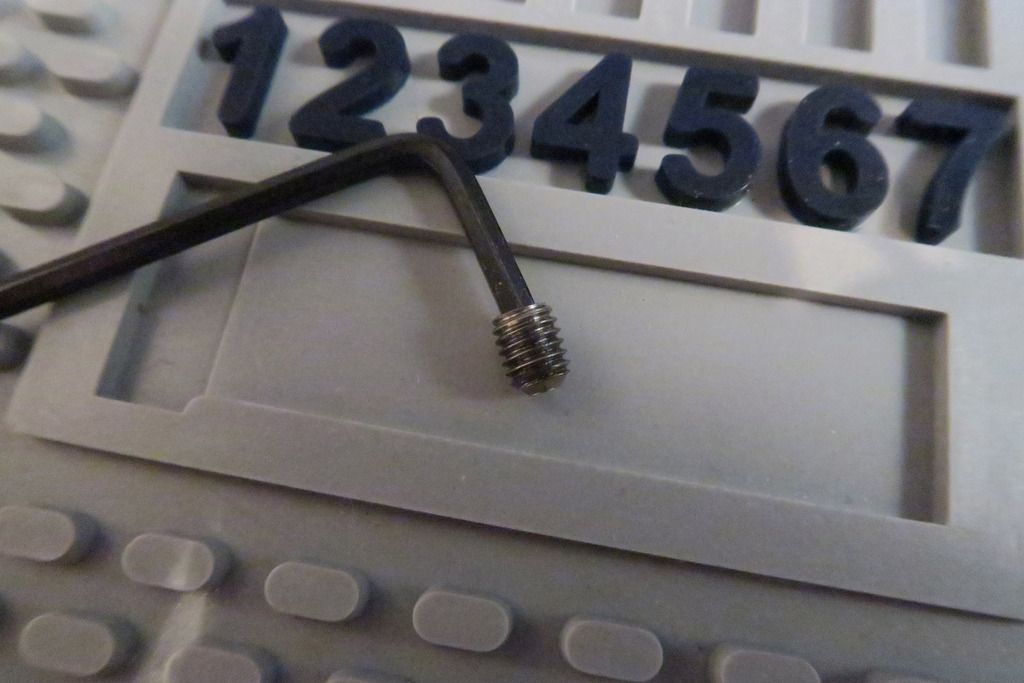
Looking down inside that hole, you’ll see the end of a metal rod. I found that my rod was greased up, so it would not fall out just through gravity and tapping the lock body:
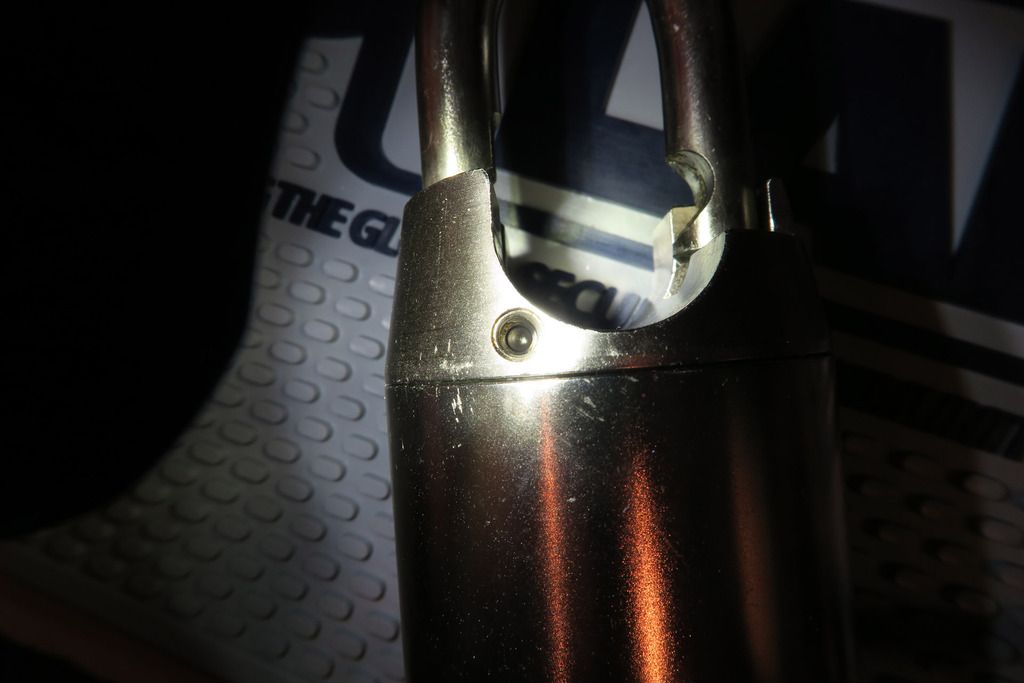
Instead, use your tiny hex key (or whatever you have around) to push out the bolt from the other side, like so:
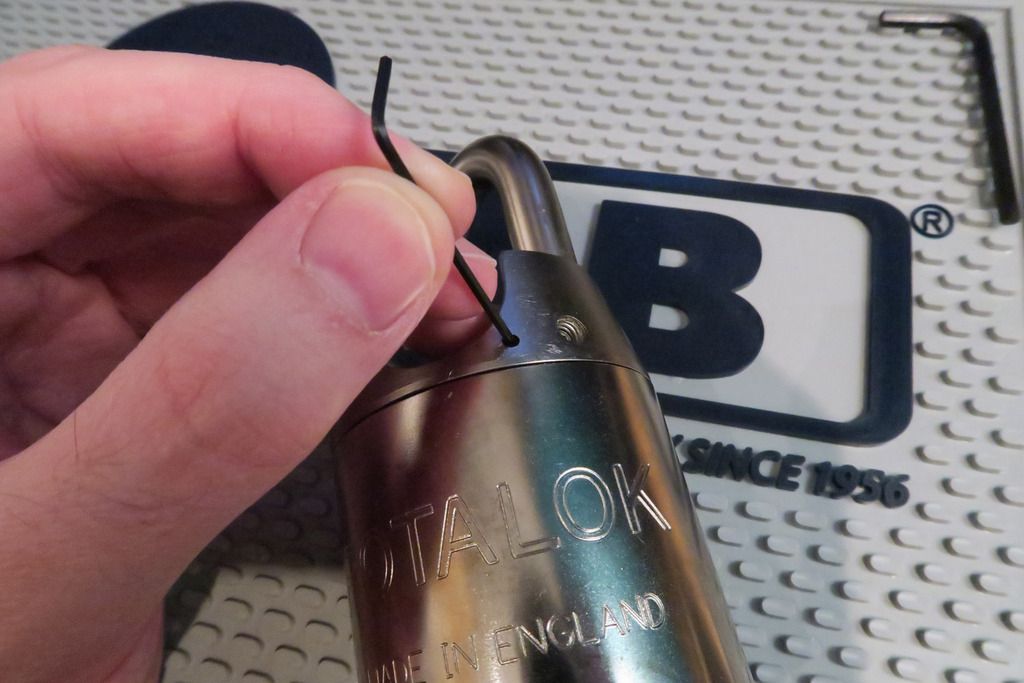

With the rod removed, you can take the shackle out without impedance:

Looking again down inside the lock, you can see the screws in both sides holding the bottom plate in place. Loving those pretty milling mark shaped even if it’s unintentional or considered inefficient or whatever:
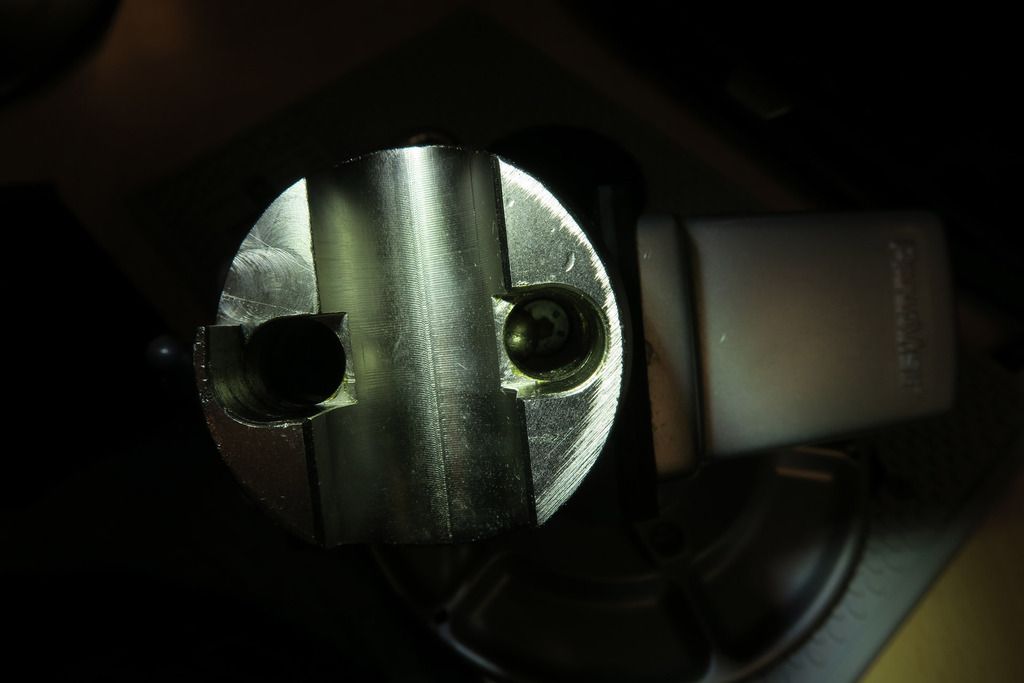
In the latter photo, you may have noticed the ball bearings sticking out into the shackle hole. If the lock is locked, these will not retract back into the body and it makes removing the screws a lot harder. However, the lock is key-retaining and the body spins, making it tough to “hold” the lock open whilst unscrewing these. My solution was to put the lock into my vice, which has two benefits – firstly, the jaws will hold the body, then you just need to “tension” yourself on the top part (shackle guard) whilst turning the hex bit (if you try and hold the clamped body, the top part (and core) will spin). Secondly, in my vice at least, the key will slide between the centre screw and one of the guide rods, preventing it from turning. You can use this trick to keep it “locked” open in the unlock position:

With the lock thus affixed, you can remove those two hex screws. If the BBs are in the way, you can just push them back into the body as long as the padlock is unlocked:
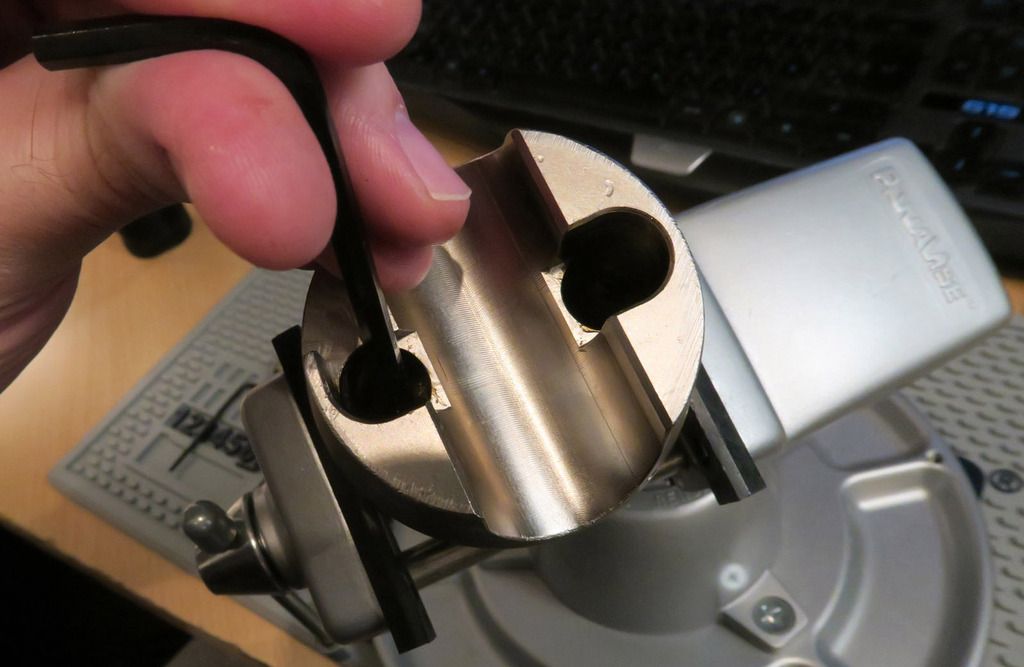
Beware that the shackle hole is pretty deep. My hex keys barely reached the bottom and I was worried I wouldn’t be able to get to the screw!:
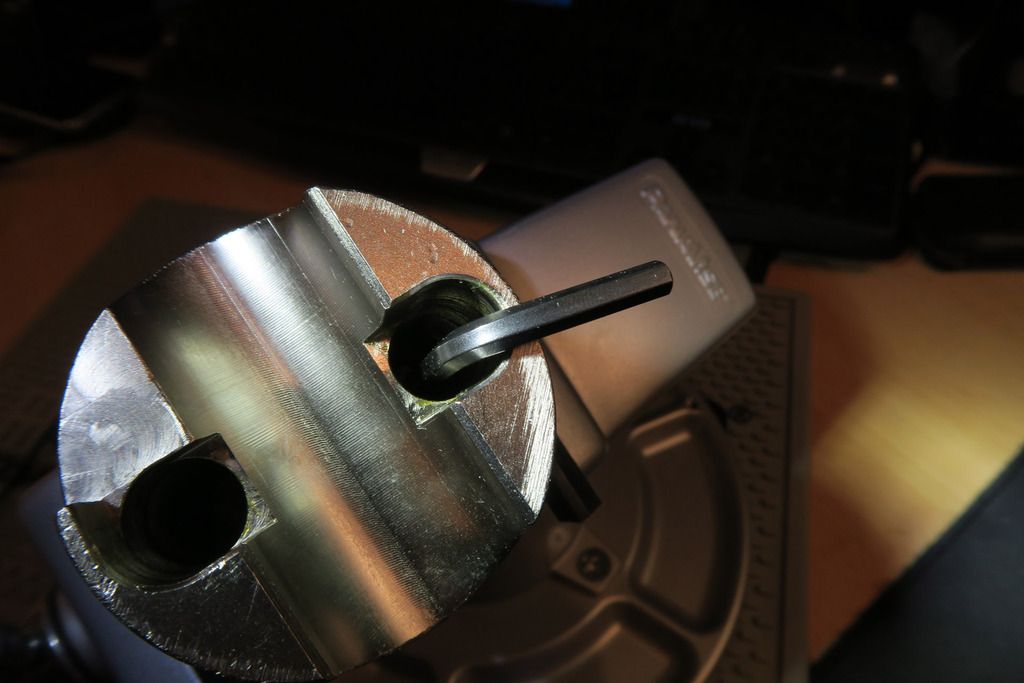
The two screws removed:
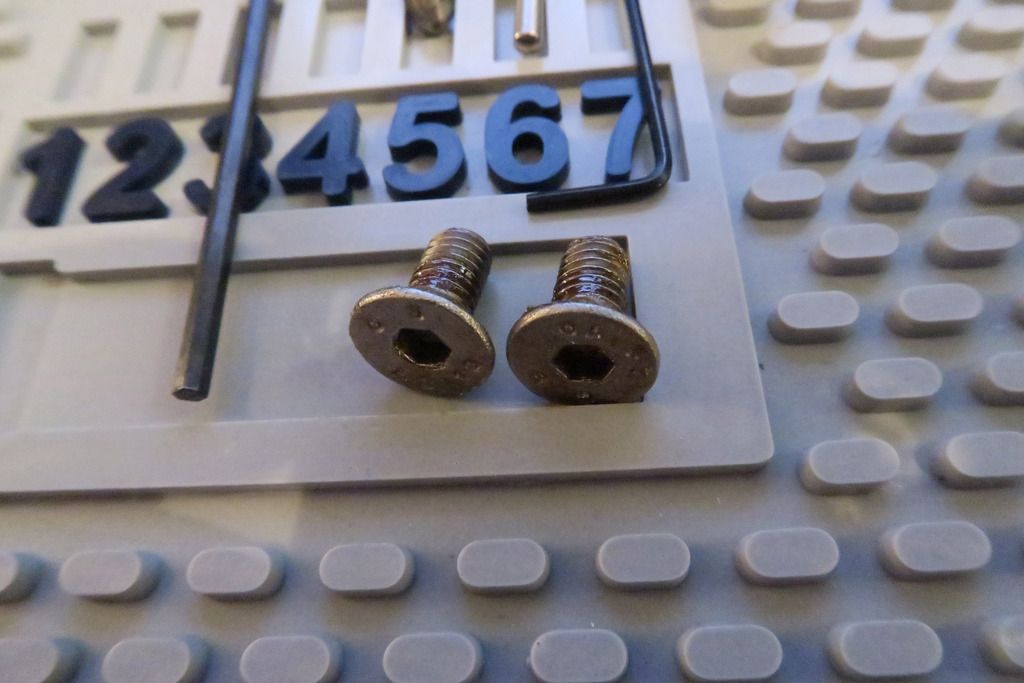
The bottom plate will now slide out. It’s pretty thick at its widest point, but only around 3mm or so at its thinnest point (where the key enters):
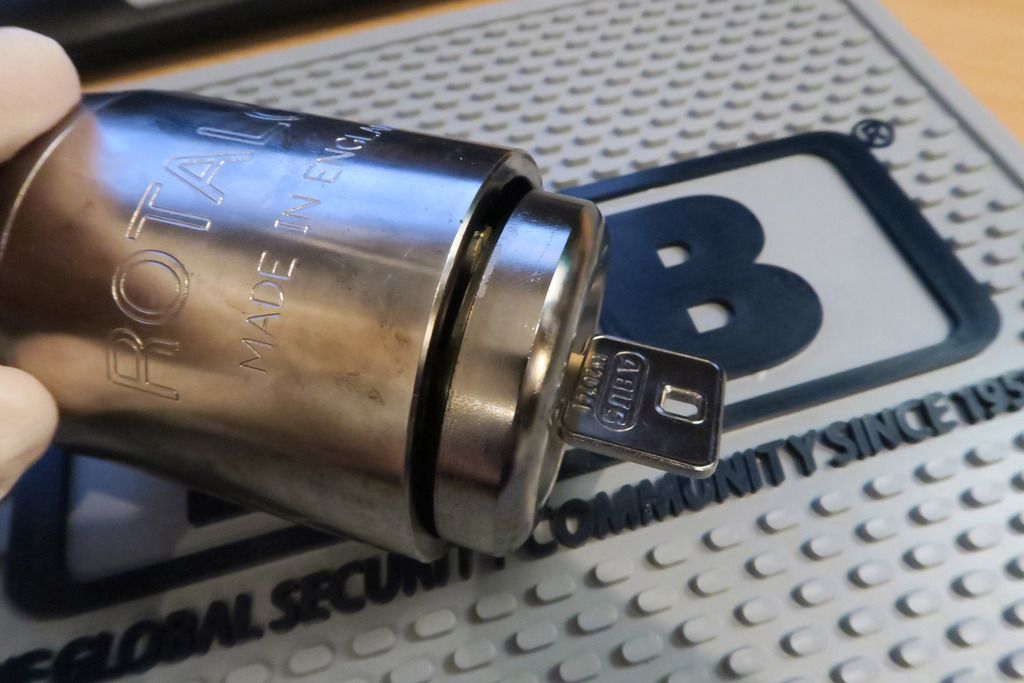
The cylinder is held to the bottom plate pretty much just with friction (it’s not needed as you can remove the cylinder easily even if the bottom plate didn’t hold onto it):
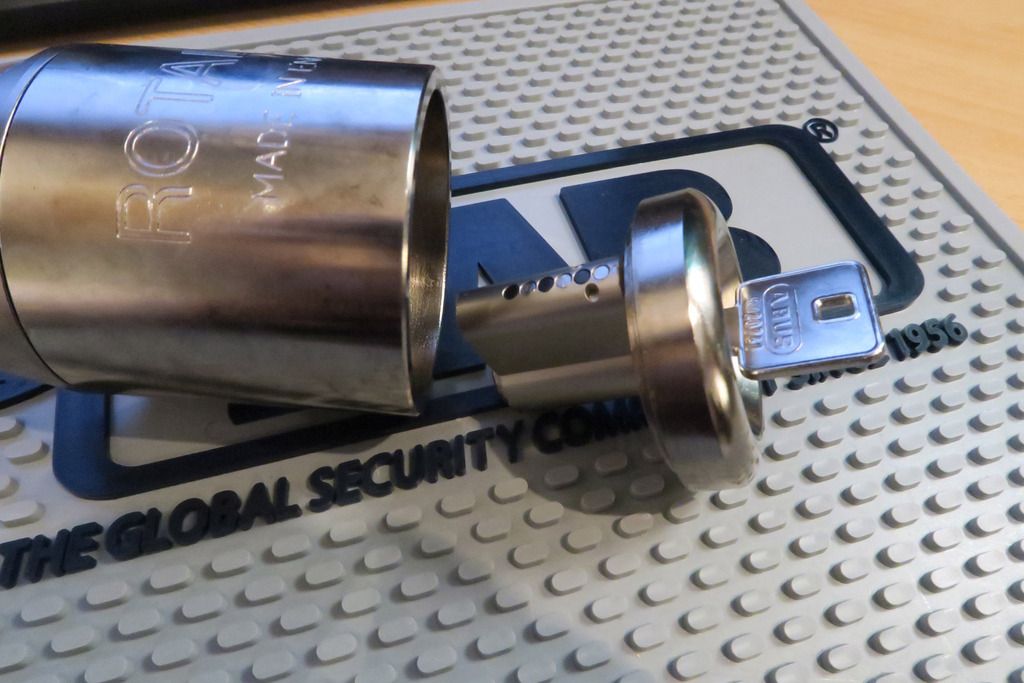
Inside shot of the bottom plate, and the supplied cylinder. It’s *very* oily and greasy on the inside of the bottom plate, which has four screws although only two are used (to align the cut-out holes for different cylinder keyways, I assume):
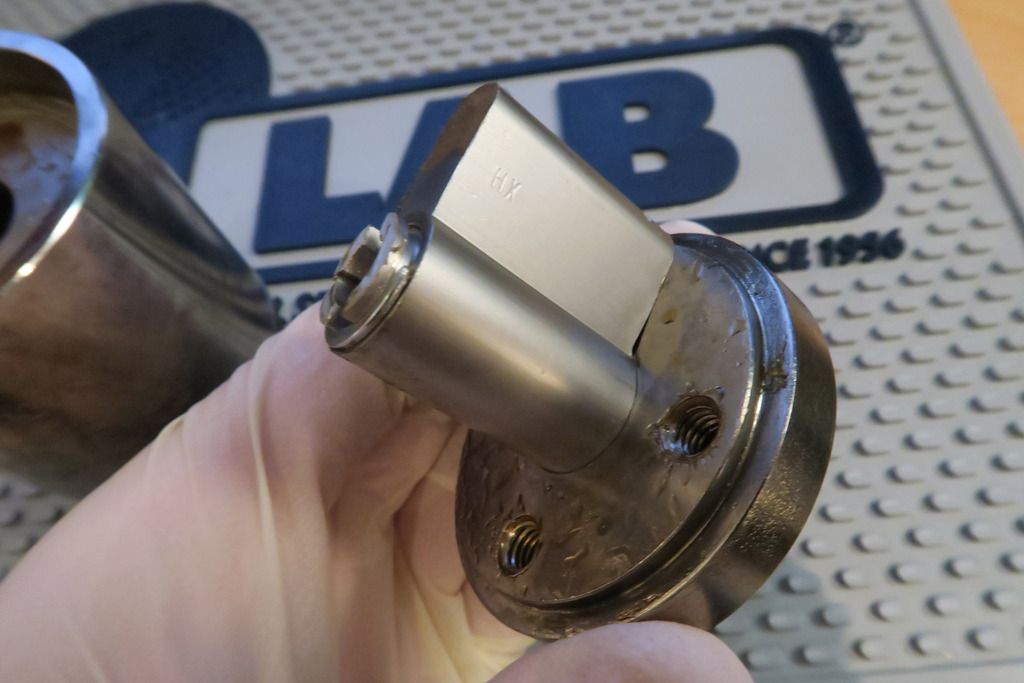
The front of the lock cylinder:
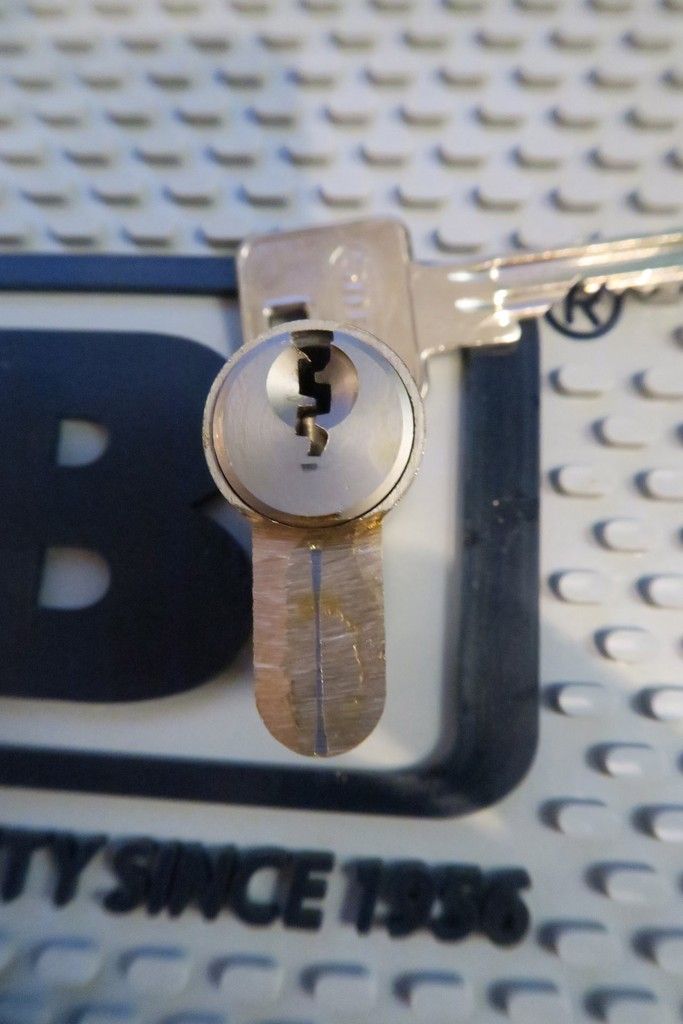
As mentioned, this is an Abus E60. Note that the bottom of the Euro cylinder has been manually filed down – in a minute you’ll see the back has, too. I’m not sure of the reason for this? Apparently this lock takes a standard 30mm half-Euro cylinder, however the standard half-Euro still has the cam at the back, and the back of this cylinder (and the lock itself) does NOT actuate with a standard Euro cam, but with the slot-part at the back of the cylinder. This makes me think that the only way to replace the cylinder in one of these locks is to buy a stock half-size or double Euro and, in either case, cut off the lock to that slot part before the cam and then file the front and back down to fit. This seems strange that a lock manufacturer would require you to basically DIY your own cylinders to fit, but in both the instances that I’ve seen this lock disassembled (my one here and BosnianBill’s one), the lock cylinder has been manually chopped down in this way. If anyone has any insight into this I’d greatly appreciate it, as I’m hoping to replace this cylinder and all the half-Euros that I can find have the cam at the back.
The top of the cylinder:
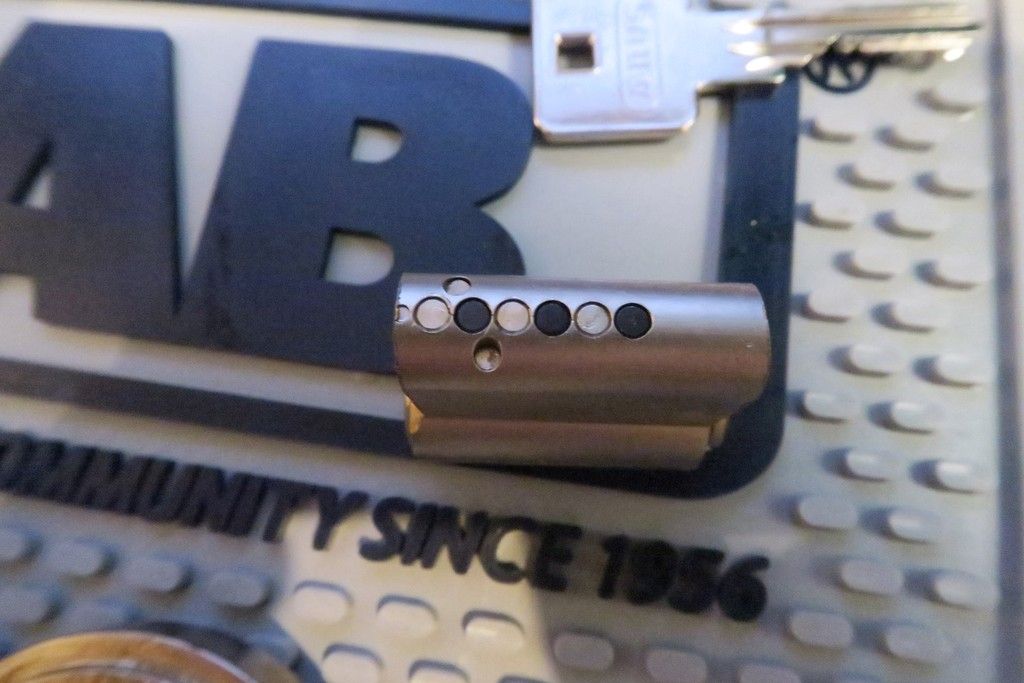
I’m not sure why every other pin guard thingy is black? Maybe there aren’t pins in these spots? I’m also not sure what these things are – they aren’t removable from what I can tell so I assume they’re some kind of permanent plug that is hammered in after the pin stack has been loaded. There doesn’t appear to be a way to remove them other than by drilling, anyway.
Here’s the back of the cylinder. As previously mentioned, it has been filed down (see the bottom part of the bible, furthest from the plug) and cut back from being a cam, to reveal just the rear part of the plug (those two crescent moon shapes rotate when the key is turned, note also the circlip holding the plug in). The gap between those two crescent moon parts slots into a flat bar at the back of the lock, which allows it to actuate the, uhm, actuator inside the lock, allowing the BBs to slide free of the shackle hole. I assume. (it appears that you can’t actually disassemble this lock – we’ll get to that):

The cylinder with key:
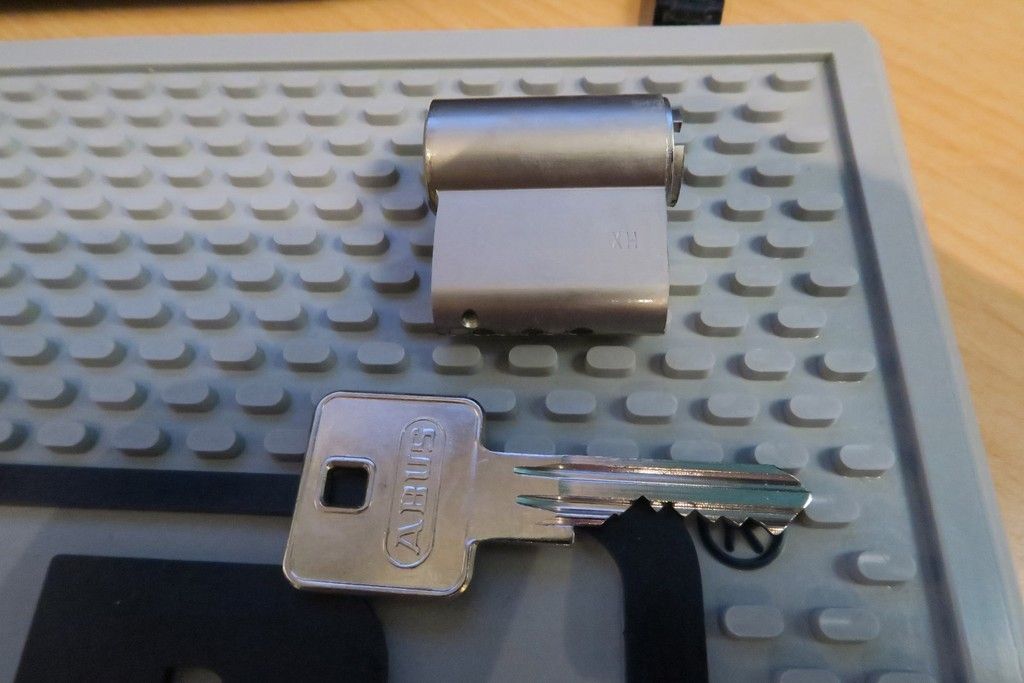
I did double check the length of this, and it is a 30mm cylinder (assuming they are measured on the bible length, not the front-to-back of the plug area:
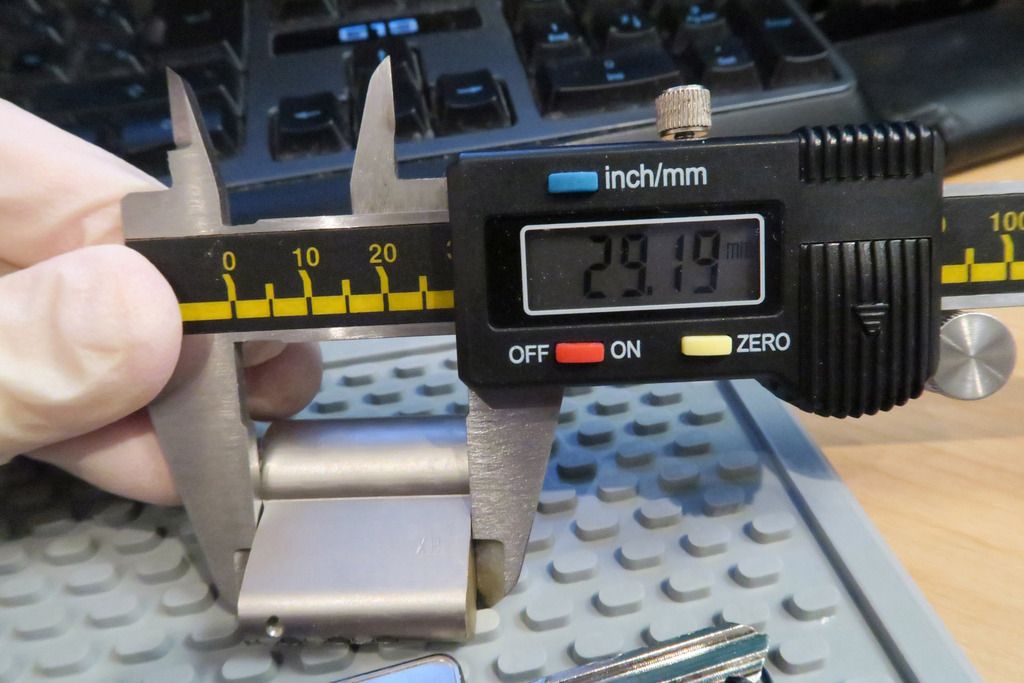
(It’s slightly less than 30mm, I assume due to the front and back being ground down, for an unknown reason)
The bottom plate:
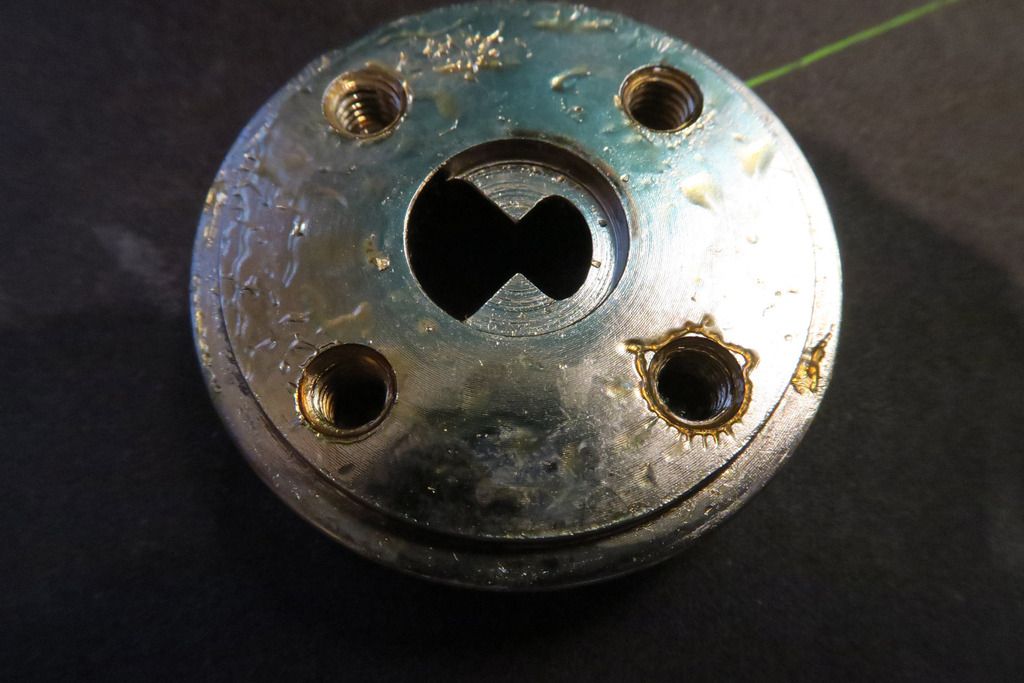
As previously mentioned, it’s oily and greasy and will soon be cleaned up.
Inside the lock:
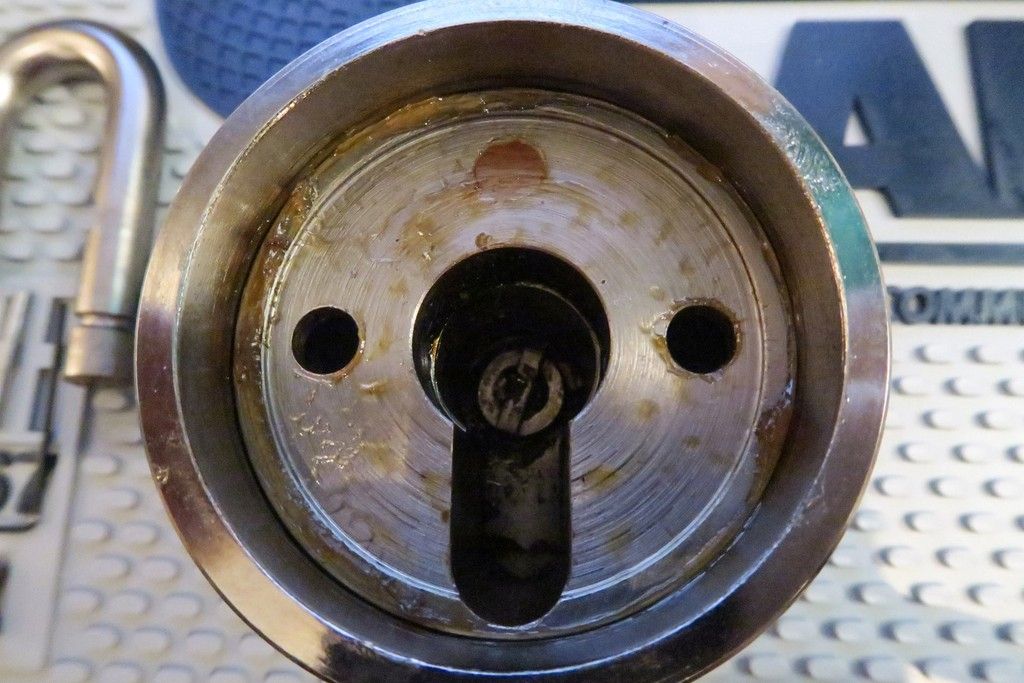
The gap between the edge of the outer casing sleeve and the inside plate with the two holes and cutout for the cylinder is where the bottom plate fits in. Because the bottom plate is recessed back, the part that contacts the cylinder fits fairly flush against the cutout edge here. I assume that all of the filing down of the cylinder was just to make it fit properly into this hole. An odd design choice – and I’ve seen this on two of these Rotaloks now. Again, if anyone has any insight into why this is needed, I’d appreciate it!
The two round holes are where the screws come through from the shackle holes and secure the bottom plate to the inner plug. You can also see the flat bar actuator at the end of the Euro cut-out which fits into the notch in the cylinder as I previously mentioned.
The lock came very gross and oily inside – not just oil but this thick, black, tar stuff. I’m wondering if it’s cosmoline or something similar, rather than grease – or maybe mixed with grease:
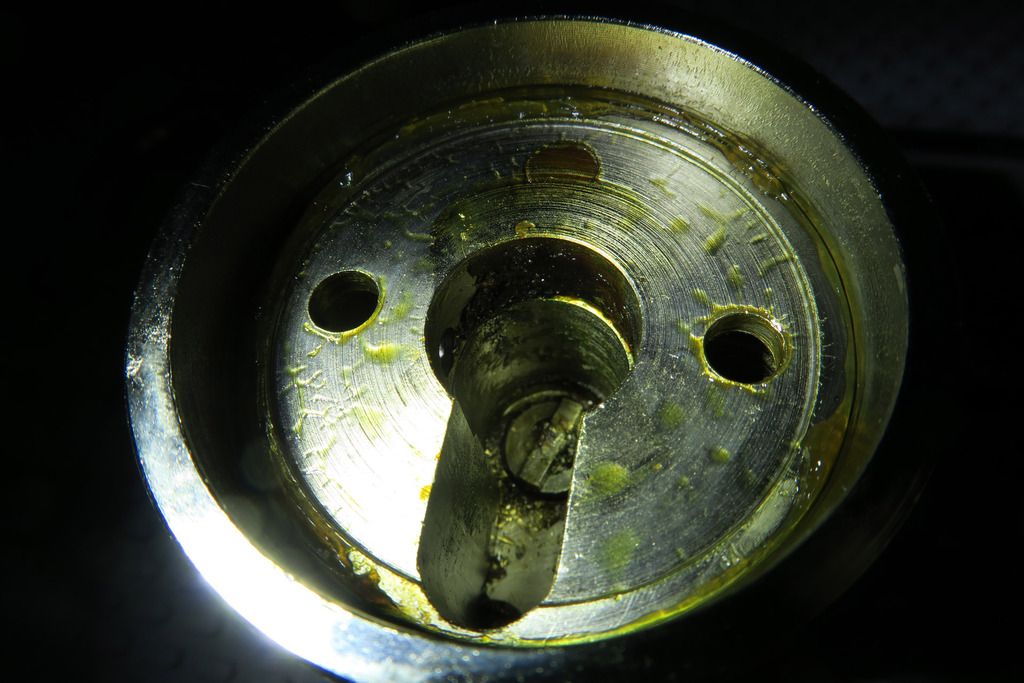
There is definitely lock oil coming out from between the outer sleeve and the inner plug – presumably the ball bearings between the body and outer sleeve were oiled up before the lock was closed, and as the outer sleeve is rotated, oil oozes out a little through the gap between body and outer sleeve as you can see here. I assume that’s why it’s so oily between the inner plug plate and the bottom plate – there would be no reason to lube those as the bottom plate is fixed to the inner plug plate by screws. The oily substance inside the Euro cutout consists of a very sticky, tar-like residue that seems to be made up of thickened lock oil and some kind of blackish-brown gloop, along with small shiny brass coloured shavings that seem like brass metal dust.
Figuring out how to clean this has proven a challenge. Lacking any proper cleaning materials, the shackle was easily given a rudimentary cleaning with WD-40 and a soft cloth:
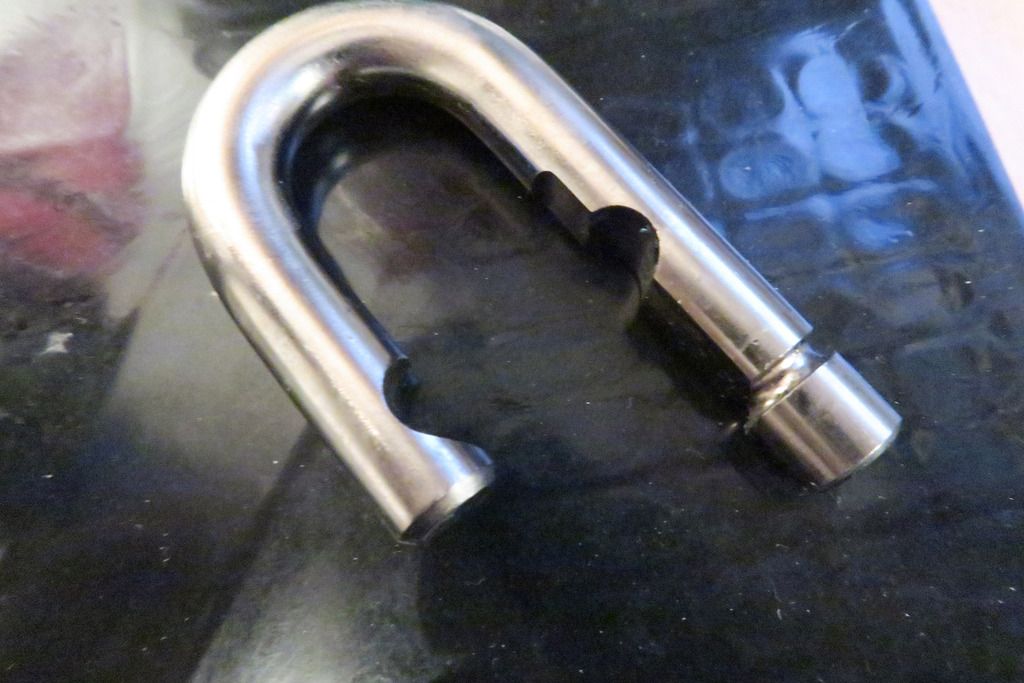
Same for the bottom plate:
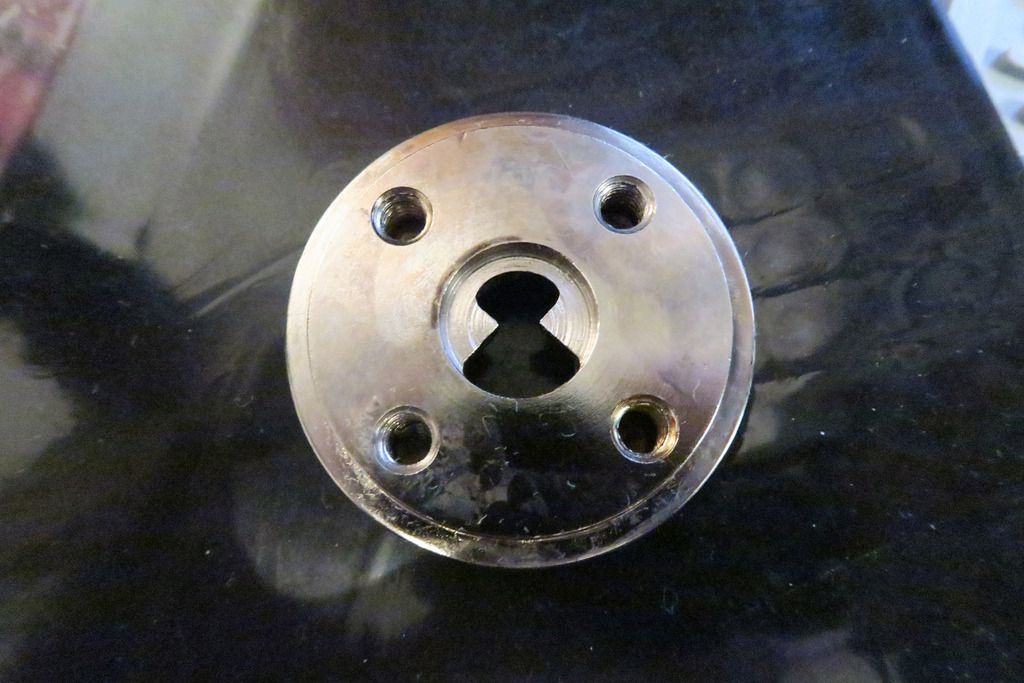
And screws/shackle bar:
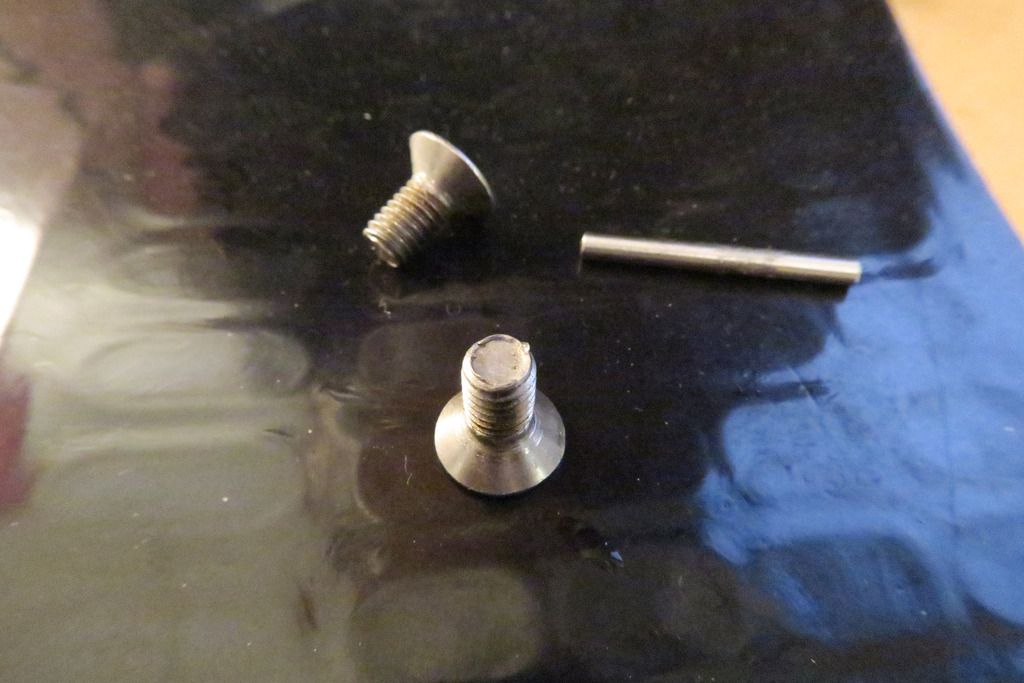
However I didn’t want to just start spraying WD-40 into the lock, because I couldn’t figure out any way to separate the outer body sleeve from the inner plug, or even get to the actuator. If I soaked the think in WD-40, I’d have no way of re-lubing these parts (and I know that WD-40 is a terrible idea to use inside of locks anyway, so I try to only use it where I can clean it off again, as I don’t currently have anything more suitable for cleaning locks – although this gloopy internal substance is something else, anyway).
I started off trying to figure out if there was a way to disassemble the lock. This is when I removed that grub screw on the shackle guard, on the side near to the small push-through hole:
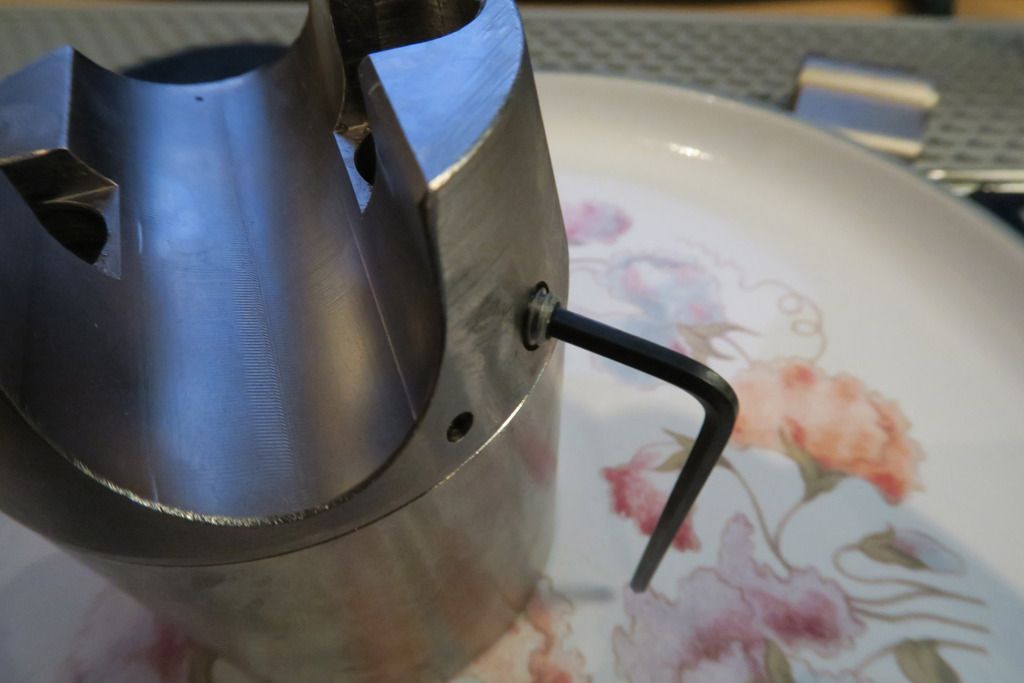
However upon removing the screw it was clear that there was nothing behind it – just solid metal, no push-through hole on the other side and I was not able to unscrew or pull off the shackle guard from the body nor the rotating sleeve from the rest of the assembly – I’ve got no idea what this screw’s purpose is, or maybe the body is just rusted, but I’ve been unable to find a way to disassembly this lock.
In the end, I decided with my limited tools and access to the lock internals that the best solution would be to douse a flannel in WD-40 and use it and some cotton buds to manually clean the inside as much as possible without causing excess WD-40 to drip into the internals:
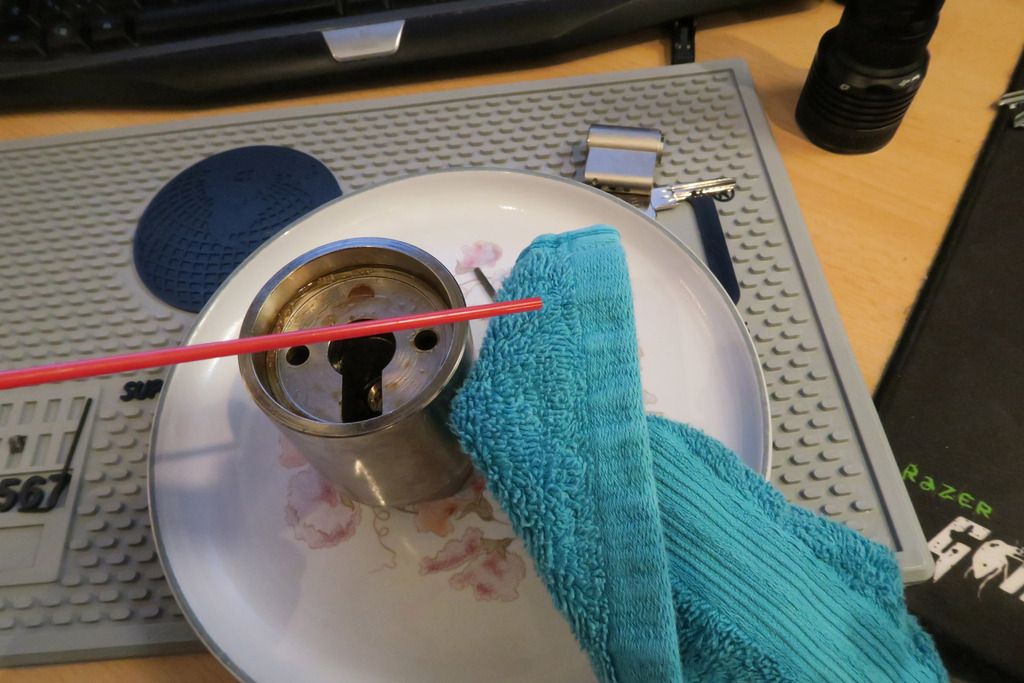
I also prepared a little pot of WD-40 to dip cotton buds into (made from the cotton bud lid itself):

This is the stuff that’s coming off from the inside of the lock. Brownish-orange thick gloop mixed with some kind of lock oil, and little brassy-yellow bits inside the brown gloop:

Here’s the lock after cleaning. Not perfect (and I can’t get into the internals – sleeve BBs, Actuator or locking BBs – to clean them), but better than nothing:
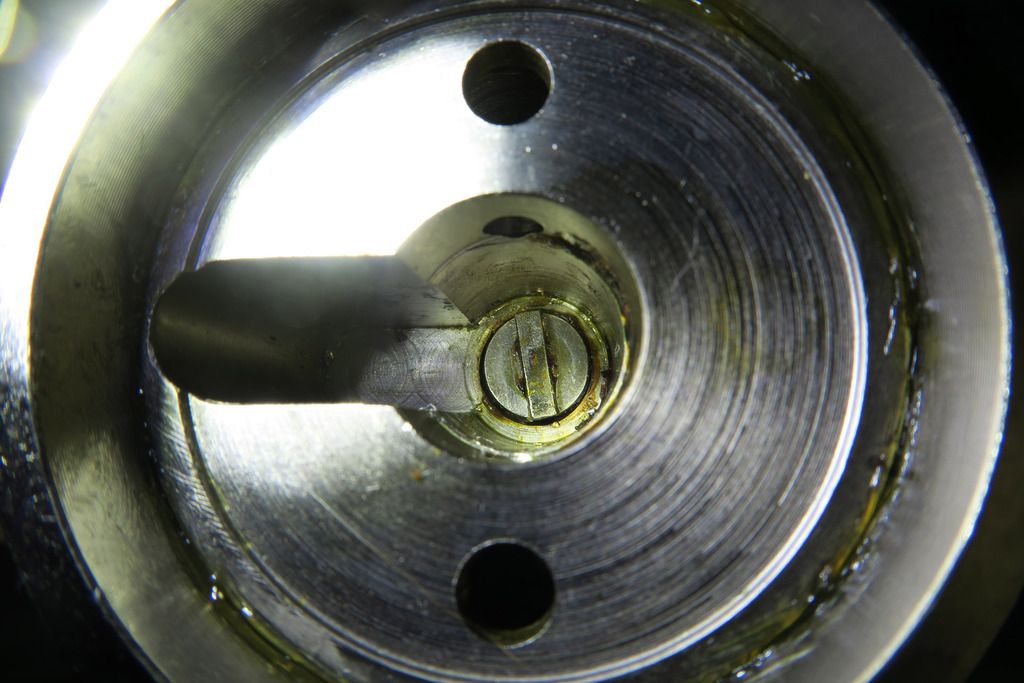
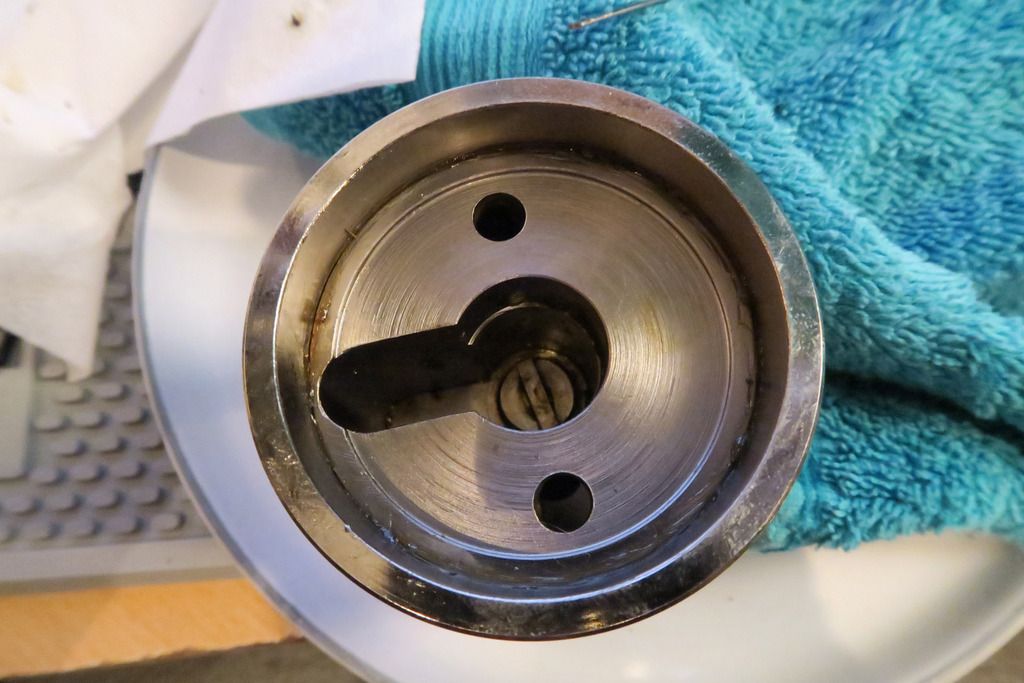
I then re-lubed the inside of the Euro cylinder, the actuator slot at the back, and this front area for good measure:
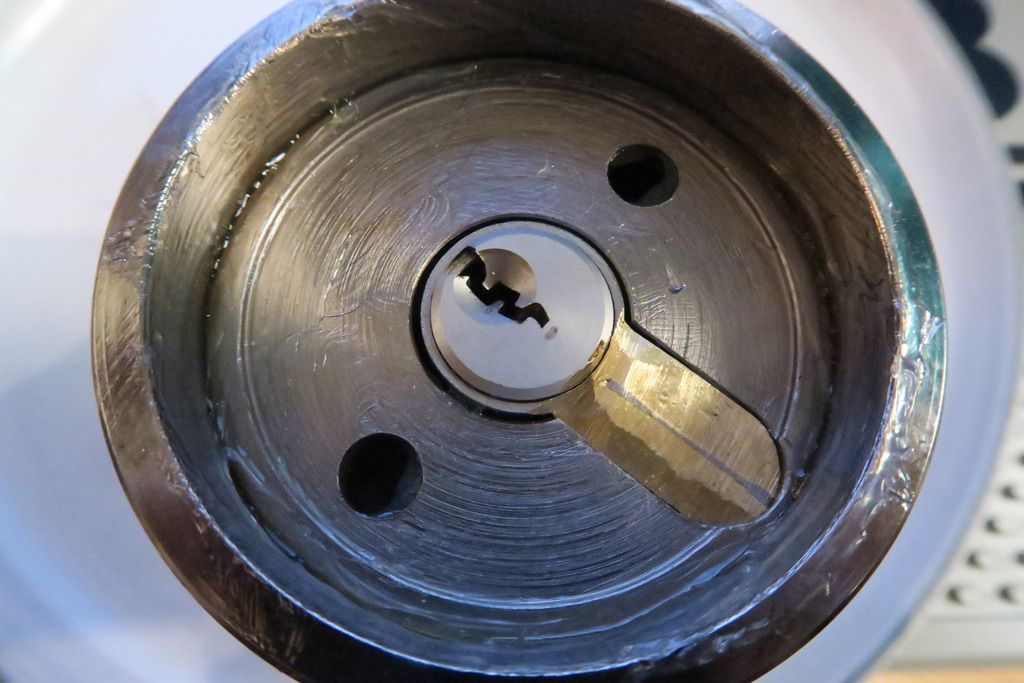
And WD-40d the outside of the body too:
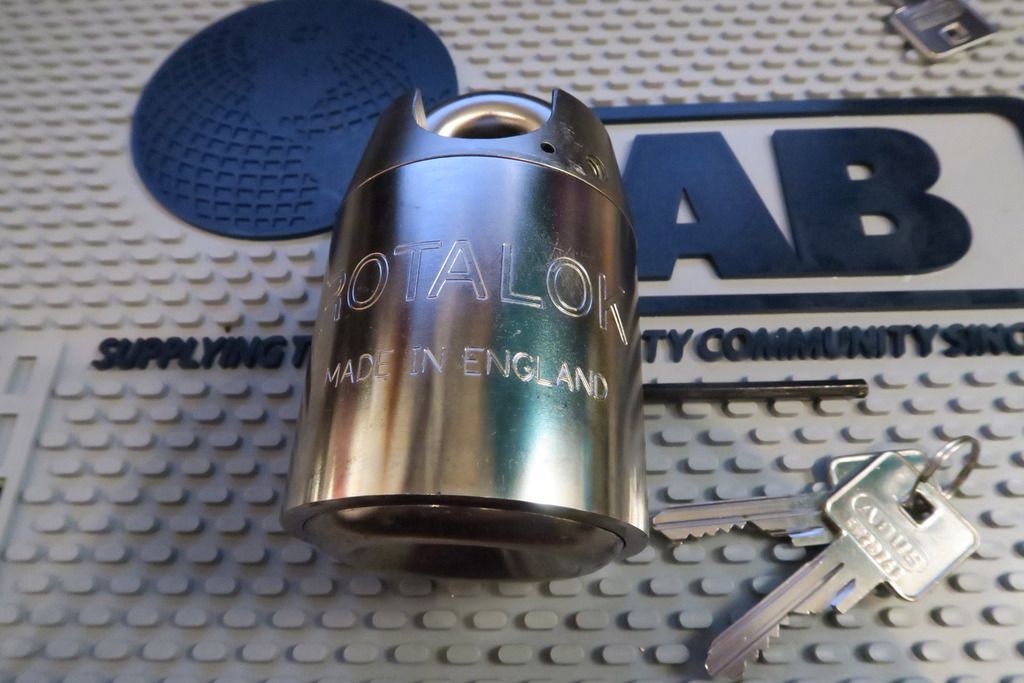
Sadly the outer body is still tarnished with odd colour marks, and the inside isn’t as clean as I’d like. Obviously I’d like to replace the cylinder too. I was thinking about getting a DOM Diamant, but I’m not sure if having a round key rather than a normal flat pin tumbler/dimple key would allow the actuator to be turned too far. Also, like all other Euros, even the single sided Diamant seems to come with the actuator attached, E.G.
Here,
Here and
Here (Last link is a photo of a double, but I assume it’d be the same issue for a half).
I’m wondering whether that’s a certain type of cylinder that I need to buy – a Euro without the actuator – and whether there’s a special term for this that I’m missing, or whether it’s literally a case of buying a half-cylinder with the actuator intact and manually dremelling the back off and grinding the front and back of the bible down to fit into the lock...
Thus, my remaining work with this lock is to:
1. Figure out a way to disassemble this lock completely, if possible.
1.5. Find a better cleaning solution and clean up the rest of the lock internals, re-greasing before re-assembly (I’m currently using Silicone grease paste as the lubricant).
2. Find a product to clean or polish the outer shell of the lock, removing the blemishes/discolouration and restoring it’s chrome-y shine.
3. Source a half-euro DOM Diamant either without the cam or modifying it to be without the cam and fit into the lock.
If anybody can assist with any of these steps (e.g. suggest cleaning or polishing solutions, disassembly instructions and locating the correct cylinder type and/or a source for the DOM Diamant) I’d be greatly appreciative

.
Either way, that’s it for this review! If and when I come back to this lock I’ll be sure to post here. Thanks for reading!


